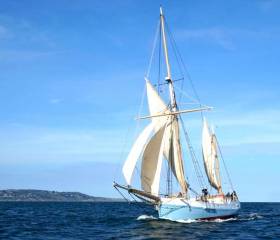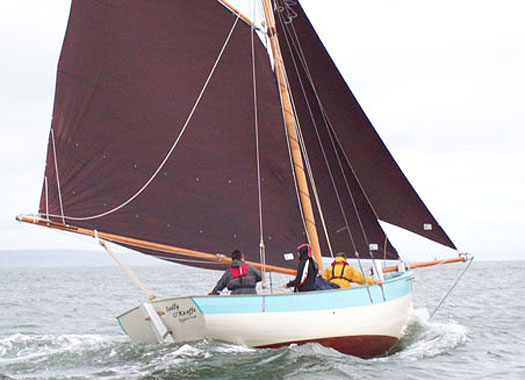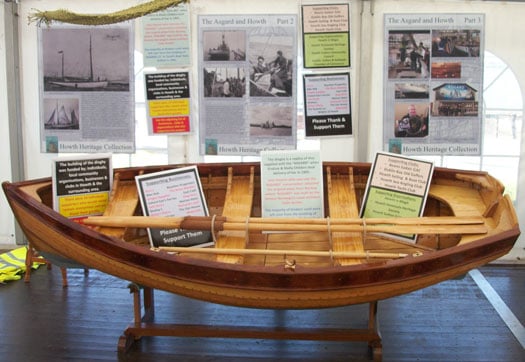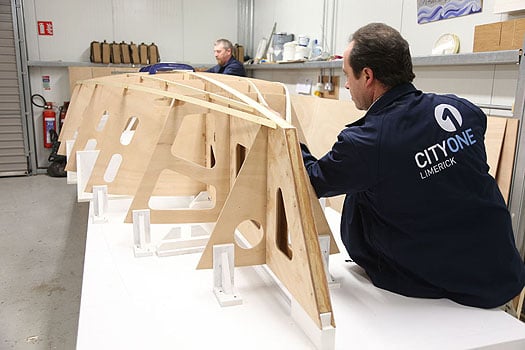Displaying items by tag: Wooden Boats
Baltimore Wooden Boat Festival Welcomes Restored Ilen Home to Her Birthplace After Historic Dublin Visit
Three million euro - every bit of €3 million writes W M Nixon. That’s what the late Theo Rye, internationally-recognised expert on the restoring and re-building of classic and traditional craft, reckoned that breathing new life into Ireland’s historic 56ft trading ketch Ilen would have cost – at the minimum - if the project had been awarded on a fully professional basis to some comprehensively equipped, properly qualified and economically efficient specialist boatyard in the heartlands of the top end of boat-building skills, in places such as The Netherlands, or at select yards around the Solent, or somewhere up in Denmark.
However, the restoration of the 1926-built Ilen, in a joint effort by the Ilen Boat-building School in Limerick and Liam Hegarty’s Oldcourt Boatyard near Baltimore, has certainly produced a fully restored little ship which exudes quality and authenticity. But thanks to special efforts by all involved, there is no way that the cost has been remotely near that jaw-dropping figure of €3 million.
Yet while the sums have been much more manageable, every cent of it has had to be secured from one source or another, and by this stage Gary Mac Mahon of Limerick – the inspiring overall promoter of the Ilen ideal – can probably fill out grant applications and benevolent funding proposals in his sleep.
 Captain Gerry Burns, shipwright Liam Hegarty and Ilen Project Director Gary MacMahon at the Ilen reception in the Royal Irish YC. Photo: Dermot Lynch
Captain Gerry Burns, shipwright Liam Hegarty and Ilen Project Director Gary MacMahon at the Ilen reception in the Royal Irish YC. Photo: Dermot Lynch
Now, however, the fact that Ilen is in full seagoing commission and properly certified - following her annual inspection by official specialists in Baltimore a fortnight ago - gives people something very tangible to grasp when support is sought.
Rather than the high-flown but inevitably vague talk of times past, and thoughts of increasing respect for Ireland’s sometimes hidden maritime traditions while also honouring the memory of Conor O’Brien whose seafaring achievements directly resulted in Ilen being built in the first place, we now have something real. A proper little ship with which we can all identify. A little ship which nevertheless still needs a steady flow of real money to keep up the good work of adding interest to international school projects, implementing programmes like Sailing Into Wellness, and giving extra meaning to environmental campaigns.
Thus last weekend’s extended visit to Dublin, with target points for shoreside interactions with well-wishers at Poolbeg Yacht and Boat Club in the Liffey, the Royal Irish Yacht Club in Dun Laoghaire, and the heart of Howth Harbour during the annual Prawn Festival, were all occasions with multiple purposes.
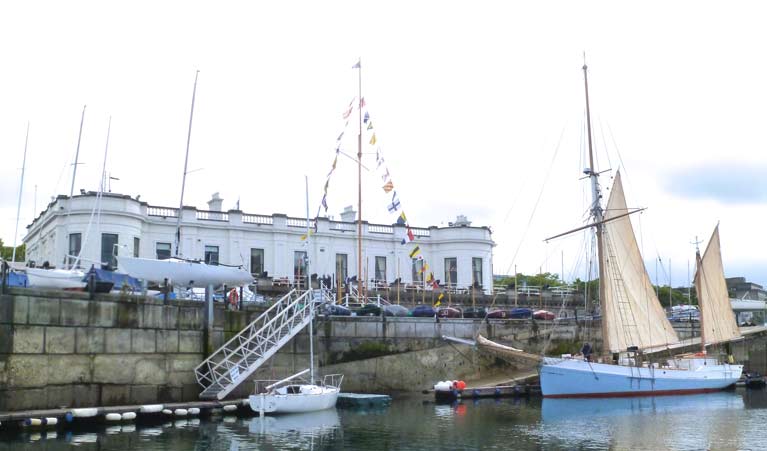 When the Ilen arrived at her berth at the RIYC, it had only recently stopped raining, but by the time the reception got underway, the sun was shining. Photo: W M Nixon
When the Ilen arrived at her berth at the RIYC, it had only recently stopped raining, but by the time the reception got underway, the sun was shining. Photo: W M Nixon
At its most basic, there was the opportunity for people who had a vague feeling of goodwill towards the ship to actually see her and go aboard. Then for those who knew something of what the restored Ilen really meant, there was an opportunity to inspect and wonder at the quality of the restoration, and the skills of creative design which have been used to turn a little freight and ferry ship into a proper long distance voyager with comfortable crew accommodation, yet with enough space to be a floating classroom.
This weekend, Ilen is the star of the annual Baltimore Wooden Boat Festival. But while many memories are vivid from last weekend’s time in Dublin, there’s no doubt the highlight was the re-launch ceremony at the Royal Irish Yacht Club in Dun Laoghaire, a club with which the Foynes Island sailor Conor O’Brien from County Limerick had special links.
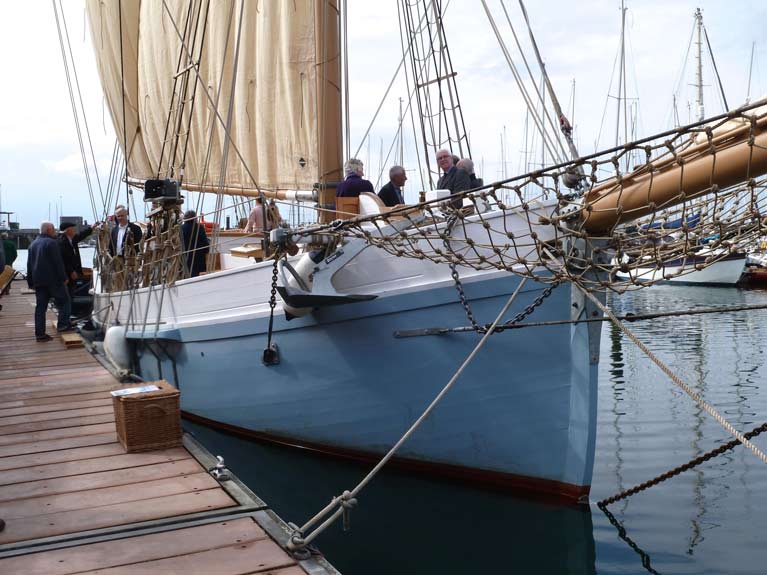 A seriously traditional ship – Ilen at the RIYC berth with the sun coming through and visitors beginning to flock on board. Photo: W M Nixon
A seriously traditional ship – Ilen at the RIYC berth with the sun coming through and visitors beginning to flock on board. Photo: W M Nixon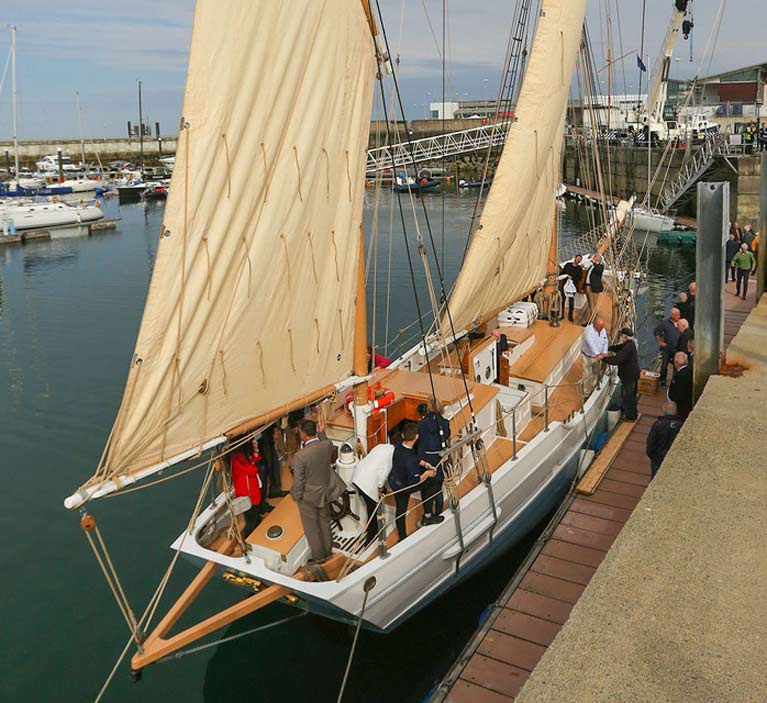 Ilen’s localised area of sunshine lasted for most of the reception at the RIYC. Photo: Deirdre Power
Ilen’s localised area of sunshine lasted for most of the reception at the RIYC. Photo: Deirdre Power
However, as this interaction was at its height in the 1920s, it’s clear that for many of today’s sailors, knowledge of O’Brien and his achievements are vague in the extreme, so the background to the story provides a useful context for the speech of welcome and encouragement which came from RIYC Commodore Joe Costello.
 RIYC Commodore Joe Costello welcomes the Ilen back to his club’s fleet after an absence of 93 years. Photo: Deirdre Power
RIYC Commodore Joe Costello welcomes the Ilen back to his club’s fleet after an absence of 93 years. Photo: Deirdre Power
Conor O’Brien of Foynes Island in the Shannon Estuary in County Limerick lived from 1880 to 1952. A grandson of William Smith O’Brien of the Young Ireland movement, he was firstly a mountaineer who then became a pioneering ocean voyager when he was the first amateur sailor to circumnavigate the world south of the Great Capes including, of course, the legendary Cape Horn.
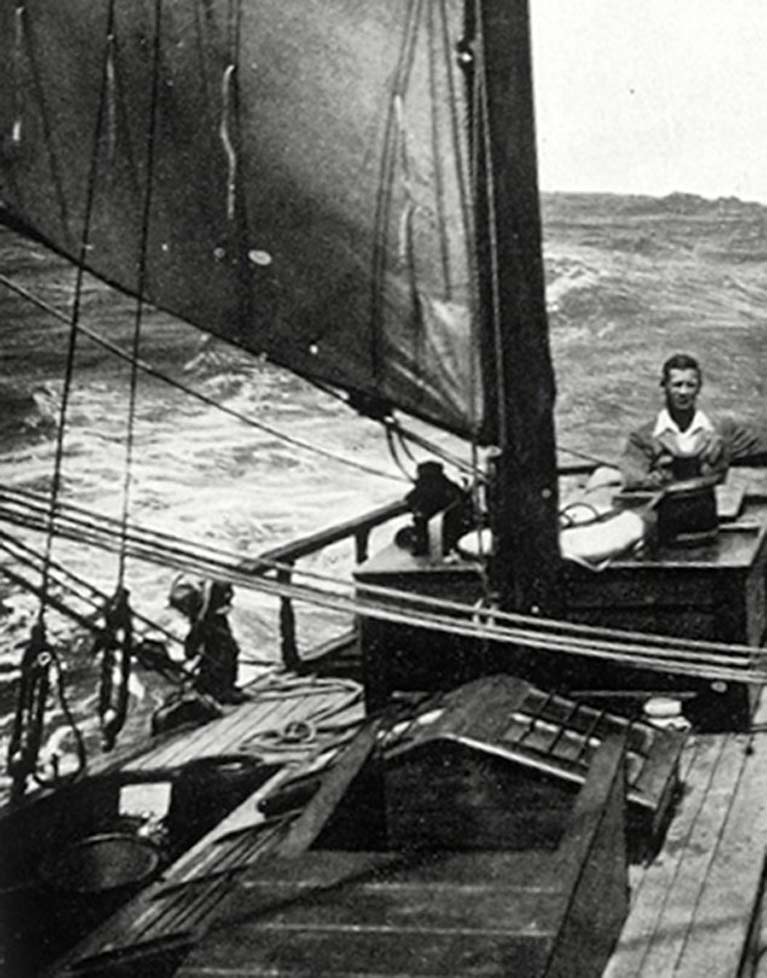 Conor O’Brien at the helm of Saoirse during the 1923-1925 round the world voyage, which began and ended at the RIYC
Conor O’Brien at the helm of Saoirse during the 1923-1925 round the world voyage, which began and ended at the RIYC
He did all this in 1923-1925 in the little 42ft gaff ketch called Saoirse, which he designed himself and had built by Tom Moynihan and his master shipwrights in Baltimore in West Cork. She was called Saoirse – “Freedom” as it is in English - to celebrate the establishment of the Irish Free State, of which he was a strong supporter – so much so, in fact, that he had aided Erskine Childers in the Howth gun-running of 1914, although he and Childers took opposing sides on the acceptance of the post War of Independence Treaty of 1921.
O’Brien withdrew from active political involvement, and instead devoted himself to getting his ideal of an ocean voyaging vessel built in Baltimore in 1922. Although he claimed that, in the first place, all his voyages really started and finished at his home port of Foynes Island, officially it was from his club, the Royal Irish YC in Dun Laoghaire on the 20th June 1923, that Saoirse’s great voyage got under way. And exactly two years later, on Saturday, June 20th 1925, Conor O’Brien and his little ship returned in triumph to this same spot, his magnificent voyage achieved.
Being a Saturday, Dublin Bay Sailing Club would normally have had a full racing programme in action. But in honour of O’Brien’s return, they cancelled racing, and their fleet provided Saoirse with a Guard of Honour as she returned to the harbour. Dublin Bay Sailing Club do not take such cancellations lightly – this was a very signal honour.
One unexpected outcome of the voyage was that when Saoirse had put into the Falkland Islands after rounding Cape Horn and sailing non-stop from New Zealand, the islanders were so impressed with the little ship’s seaworthiness that they advocated that they should have a larger version to be their inter-island ferry and freight vessel.
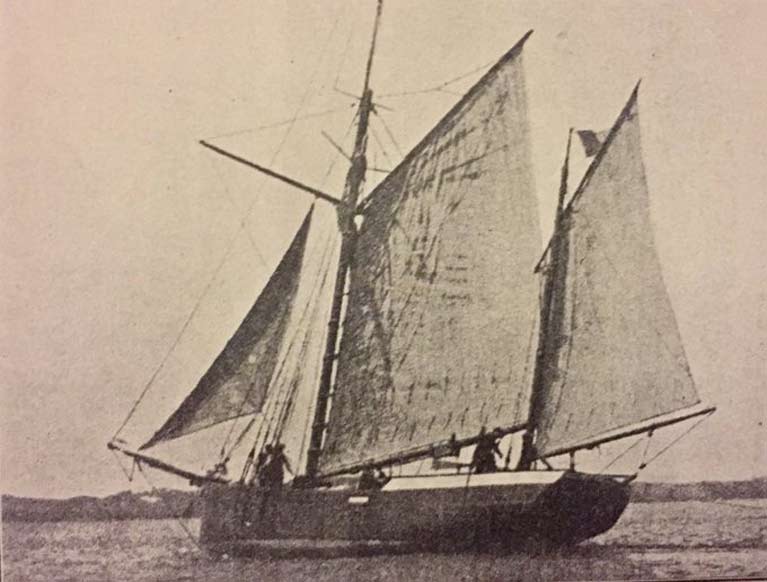 The newly-built Ilen sailing in Baltimore Harbour in 1926. Photo: Alice Foy
The newly-built Ilen sailing in Baltimore Harbour in 1926. Photo: Alice Foy
The result was that in 1926, Conor O’Brien found himself working again with Tom Moynihan in Baltimore, this time to create the 56ft ketch Ilen, which was undoubtedly Saoirse’s bigger sister.
Conor O’Brien personally delivered Ilen to the Falklands in 1926, crewed by two Cape Clear men, Con and Denis Cadogan. She was to give great service in those very rugged waters as a workboat for many decades, and when she was finally retired in the 1990s, Gary Mac Mahon of Limerick - who is both a Conor O’Brien enthusiast and a very considerable force of nature - decided that she should be shipped home to Ireland and restored to full seagoing condition in order to undertake voyaging with people who would benefit from such an experience, and also to remind us of our sometimes forgotten but nevertheless very great maritime traditions.
 Aboard Ilen sailing in Dublin Bay in May 1998, a few months after she’d been shipped back from the Falklands. At the deckhouse and living for the moment is Tim Magennis, possibly the only person in Ireland today who has sailed round the world under gaff rig Photo: W M Nixon
Aboard Ilen sailing in Dublin Bay in May 1998, a few months after she’d been shipped back from the Falklands. At the deckhouse and living for the moment is Tim Magennis, possibly the only person in Ireland today who has sailed round the world under gaff rig Photo: W M Nixon
 Tim Magennis – who recently celebrated his 90th birthday – at the RIYC after seeing the restored Ilen for the first time. Photo: Dermot Lynch
Tim Magennis – who recently celebrated his 90th birthday – at the RIYC after seeing the restored Ilen for the first time. Photo: Dermot Lynch
It was in November 1997 that Ilen was brought home. The fact that two decades later she was finally making her debut in this superbly restored style at the Royal Irish Yacht Club was doubly appropriate. Not only had Conor O’Brien used this as his start and finish point for his Saoirse circumnavigation in 1923-25, but when he came to deliver Ilen to the Falklands in 1926, he discovered that he was only insured as a Yachtmaster, and not as the Captain of a commercial vessel.
So when Ilen sailed out over the many thousands of miles of ocean to the Falklands, it was as part of the fleet of the Royal Irish Yacht Club – she flew the club burgee, and her club allegiance was proudly inscribed across her transom.
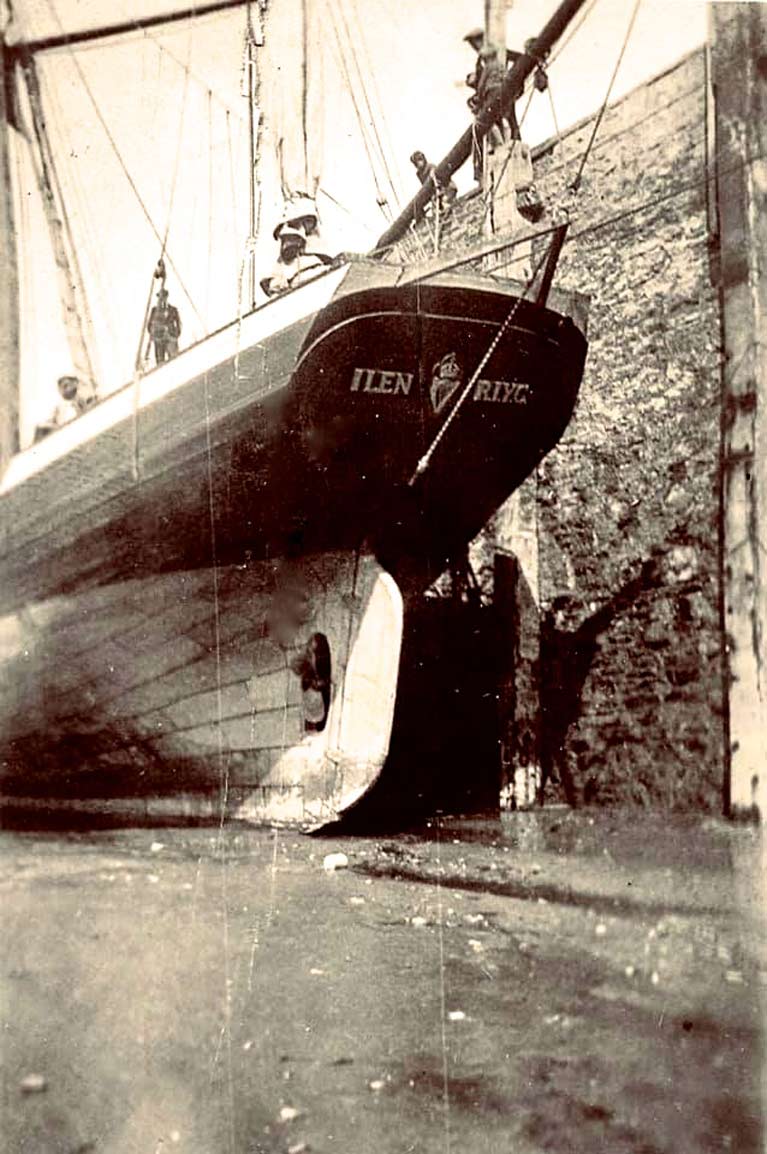
For six months, she was a yacht of the RIYC. Then she belonged in Port Stanley, and was a working boat. But now she is a Limerick ship. A little ship, perhaps, but undoubtedly a ship nevertheless, and a characterful one at that. She is very expressive of Conor O’Brien’s notions of what a hard-working seagoing vessel should look like, particularly in the matter of bowsprits. Like Saoirse before her, Ilen has a bowsprit which extends into the middle of next week, for that is the O’Brien way.
As we’re now in 2019, it is self-evident that the restoration of Ilen has been a long and challenging task, at times run on a shoestring. But thanks to the profound faith of Gary and his friends, Ireland has got to this remarkable stage of having a fully-certified seagoing traditional vessel which is currently in the midst of one of the very commendable Sailing into Wellness programmes,
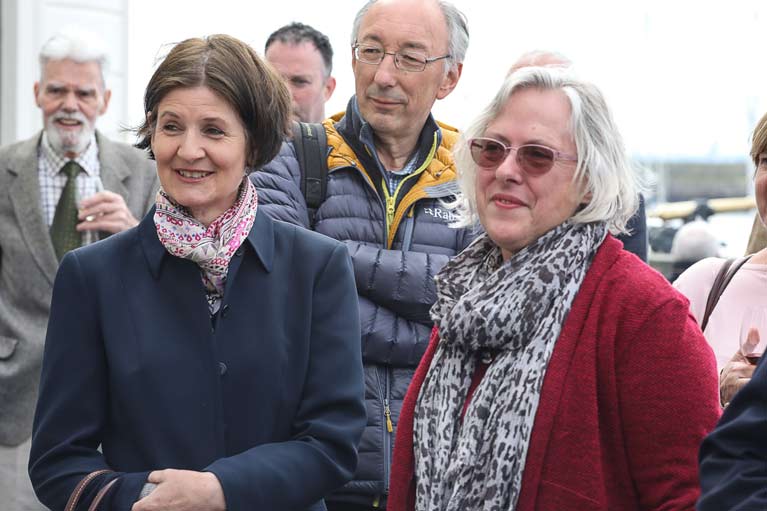 Although Conor O’Brien had no children of his own, his relatives are spread throughout Ireland – this is his grandniece Charlotte O’Brien Delamer with Stephanie O’Brien in Dun Laoghaire. Photo: Dermot Lynch
Although Conor O’Brien had no children of his own, his relatives are spread throughout Ireland – this is his grandniece Charlotte O’Brien Delamer with Stephanie O’Brien in Dun Laoghaire. Photo: Dermot Lynch
Then in July she’ll undertake a nine week educational voyage to Greenland from Limerick in the wake of the Atlantic salmon - a timely reminder of that splendid fish’s threatened status – while at the same time strengthening links which the Ilen Network has been building up between schools in the greater Limerick area and schools in southwest Greenland.
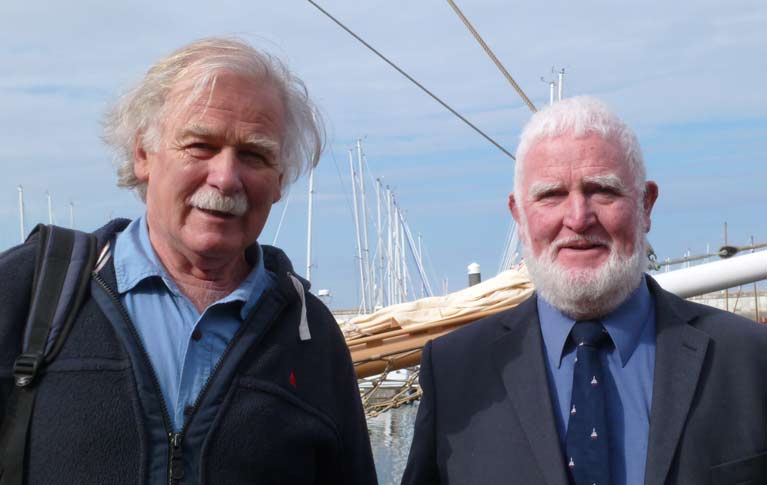 Experienced sailors of the west – Mick Brogan (left) and Jarlath Cunnane of Mayo will play a key role in bringing Ilen back from Greenland. Photo: W M Nixon
Experienced sailors of the west – Mick Brogan (left) and Jarlath Cunnane of Mayo will play a key role in bringing Ilen back from Greenland. Photo: W M Nixon
For the Ilen is now the symbol of a broad movement which has re-kindled awareness of the unique traditional vessels of Ireland, particularly those of the Shannon Estuary and West Cork. But were it not for this wonderful vessel at the centre of it all, the entire project would lack focus.
With the extraordinary balance of talents and almost magical chemistry between Gary Mac Mahon and Liam Hegarty and their respective teams, this restoration of exceptional authenticity has been achieved, aided in no small way by the spiritual support and guidance of Brother Anthony Keane of Glenstal Abbey.
 Celebrating the Ilen restoration at RIYC were (left to right) Patrick Keane SC, Deirdre Kinlen, Brother Anthony Keane of Glenstal Abbey, and Dr Sheila Javaepour. Photo: Donal Lynch
Celebrating the Ilen restoration at RIYC were (left to right) Patrick Keane SC, Deirdre Kinlen, Brother Anthony Keane of Glenstal Abbey, and Dr Sheila Javaepour. Photo: Donal Lynch
So we now have a proper flagship for the traditional and classic boat movement in Ireland, and we have a symbol for a form of sailing which is accessible to all - as such, the Ilen Project received the warmest praise from President Michael D Higgins when he visited the ship in Limerick last October.
This high-powered support for the “Ilen Ideals” was much in evidence at Dun Laoghaire’s gathering, where the presence of Dr Edward Walsh, founder of the University of Limerick, was matched by people like former RIYC Commodore Terry Johnson, whose remarkable record of service to sailing is augmented by work he has done on behalf of sail training, the lifeboat service, and other key pillars of the maritime world.
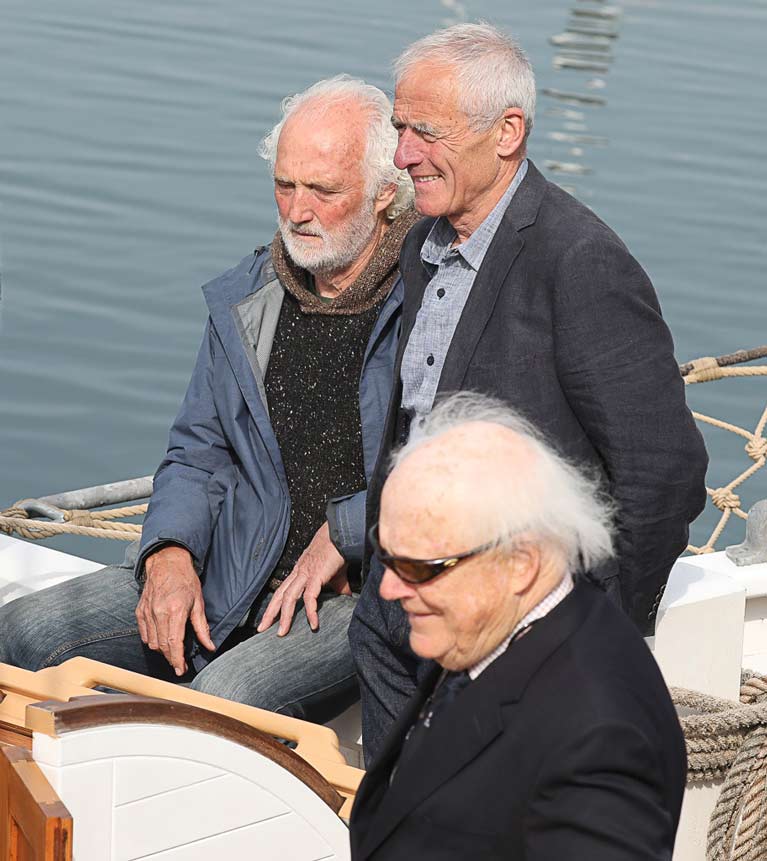 Former RIYC Commodore and maritime multi-tasker Terry Johnson (foreground) with renowned musician Brendan Begley (left) aboard Ilen. Photo: Dermot Lynch
Former RIYC Commodore and maritime multi-tasker Terry Johnson (foreground) with renowned musician Brendan Begley (left) aboard Ilen. Photo: Dermot Lynch
Also present were people who have given much practical assistance, such as Captain Gerry Burns of Irish Ferries, who in his leave periods served as a relief captain on the training Ship Asgard II. Since Ilen went afloat again, he has been journeying to Limerick to give master-classes in ship-handling to future Ilen skippers.
Another attendee was Tim Magennis, one of the few people who has sailed right round the world under gaff rig. When Ilen sailed briefly in Dublin Bay in May 1998 after she had been shipped back from the Falklands, Tim - a stalwart of the Old Gaffers Association – was one of those on board, and now 21 years later, having recently celebrated his 90th birthday, his delight in Ilen’s restoration was a joy to behold.
 Ilen Project supporter Harry Harbison, Gary Mac Mahon, and Sheila Deegan, Arts Officer of Limerick City & County Council. Photo: Dermot Lynch
Ilen Project supporter Harry Harbison, Gary Mac Mahon, and Sheila Deegan, Arts Officer of Limerick City & County Council. Photo: Dermot Lynch
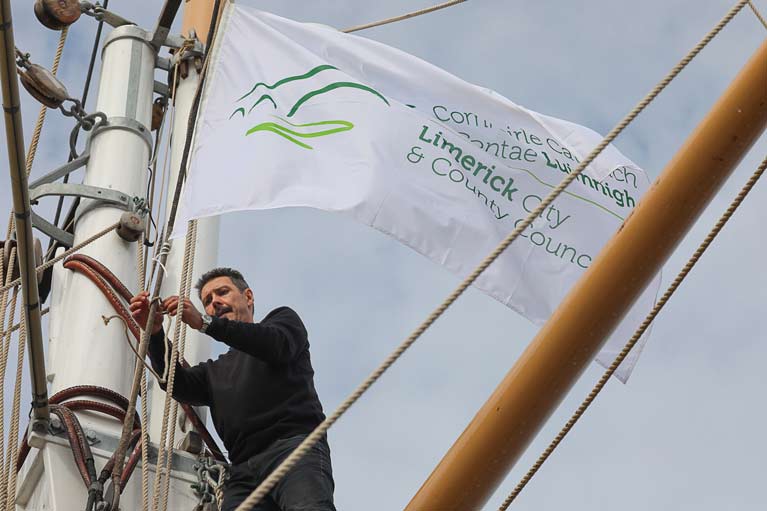 Rigging expert Trevor Ross ensures that the Limerick flag is aloft and flying. Photo: Dermot Lynch
Rigging expert Trevor Ross ensures that the Limerick flag is aloft and flying. Photo: Dermot Lynch
Although Conor O’Brien had no children, many people are related to him, and among those present were Charlotte O’Brien Delamer, his grandniece, and Stephanie O’Brien, married to another O’Brien relative.
For them, restoration of the Ilen was an intensely personal matter. But it was equally clear that many folk attending the RIYC reception found it especially moving that Ilen had been restored, and had now come to visit the club which meant so much to Conor O’Brien’s sailing.
Yet she’s a busy ship. Soon it was time to move on to Howth for a visit arranged by Wally McGuirk, where on Monday morning skipper Paddy Barry took a group of trainees from the inner-city Westland Row CBS out for some sailing experience on Ilen arranged through the Atlantic Youth Trust. Then in the afternoon, it was time to depart for Baltimore with the gift of a tankful of diesel from Howth Boat Club, on down to West Cork where the Wooden Boat Festival will serve up its own quota of emotional associations.
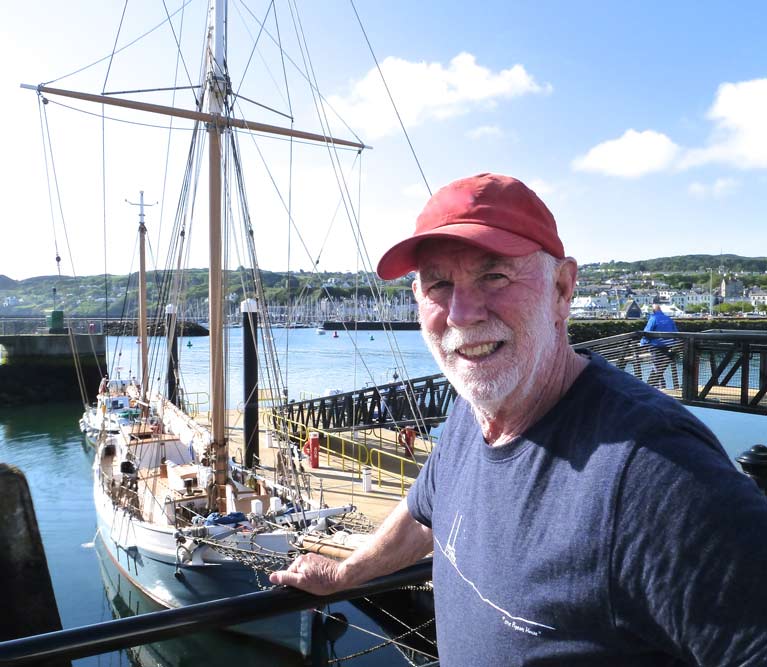 High latitudes veteran Paddy Barry with the Ilen in Howth on Monday morning. He’ll be aboard for the entire nine weeks voyage to Greenland. Photo: W M Nixon
High latitudes veteran Paddy Barry with the Ilen in Howth on Monday morning. He’ll be aboard for the entire nine weeks voyage to Greenland. Photo: W M Nixon
As a reminder of how things have slowly but steadily progressed, here’s a video by Paul Fuller of the then recently-launched and still largely unballasted Ilen making her debut at last year’s Festival in Baltimore. Now she is in full properly-ballasted seagoing order, ready and willing for further work at home before the voyage to Greenland gets underway from Limerick in July. It’s anticipation of this which will give the Baltimore Wooden Boat Festival 2019 an added dimension and an even more vivid flavour.
There’s an informal international network of wooden boat adherents - both classic and traditional - which has found in Ireland an increasingly useful source of recognised designs of intriguing boat types to provide many building challenges for skilled craftsmen and trainees alike writes W M Nixon. And they’ve also become interlinked with fellow enthusiasts in Ireland prepared to take on the ownership of the characterful boats – not necessarily from Irish designs - that result from such school projects.
This network operates at many levels. For instance, the restoration of the 56ft 1926-built ketch Ilen, in a joint venture by the Gary MacMahon-directed Ilen Boatbuilding School in Limerick working in coordination with Liam Hegarty’s traditional boatyard at Oldcourt near Baltimore in West Cork, is a very complex project which has at various times drawn in specialists from several countries, but most notably North America, and England and Scotland, in addition to sourcing much talent in Ireland.
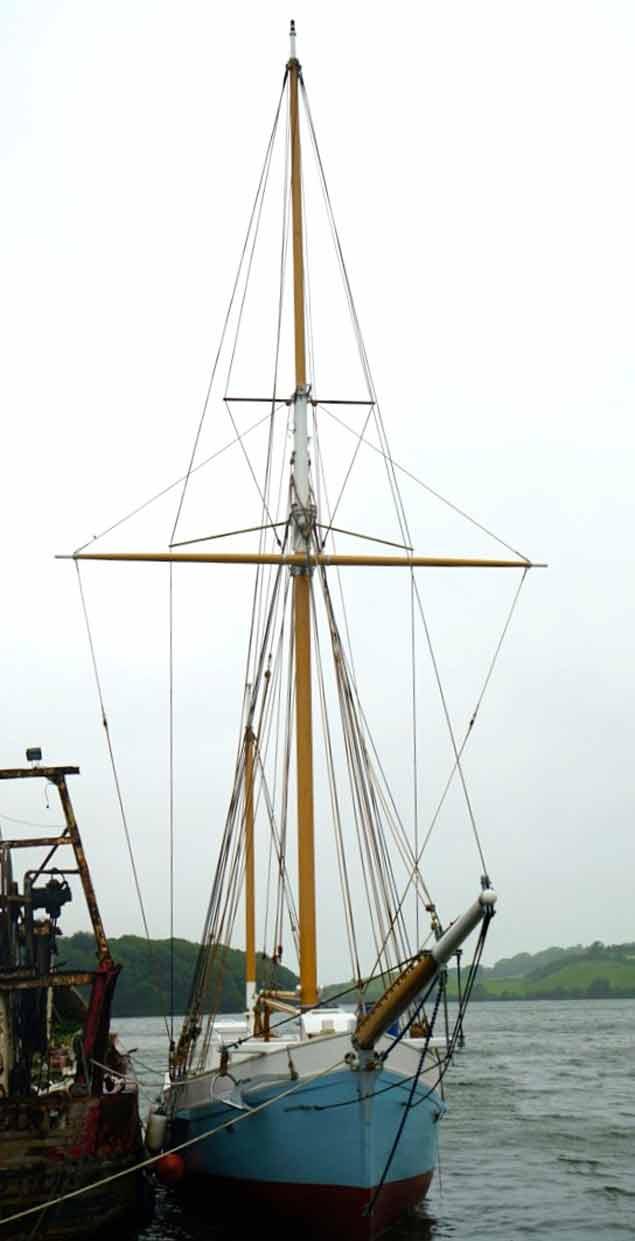 Work in progress. The restored ketch Ilen in grey weather last week in Oldcourt as she awaits the installation of ballast and the delivery of sails. The carefully-tapered squaresail yard was specially designed for the project by the late Theo Rye. Photo: Gary MacMahon
Work in progress. The restored ketch Ilen in grey weather last week in Oldcourt as she awaits the installation of ballast and the delivery of sails. The carefully-tapered squaresail yard was specially designed for the project by the late Theo Rye. Photo: Gary MacMahon
In the other direction, boatbuilders and boatbuilding schools in the UK, France, Belgium, Spain and the US have found classic Irish designs of special interest in adding variety to the courses they can provide for their pupils and apprentices. Dublin Bay 24s, Howth Seventeens, Dublin Bay Water Wags, Shannon One Designs and other time-honoured golden oldies have been born anew, the most recent instance being the exquisitely-finished new Dublin Bay Water Wag Dipper for David & Berna Williams of Dun Laoghaire, created by American Brian McClelland at his boat-building school in San Sebastian in Spain.
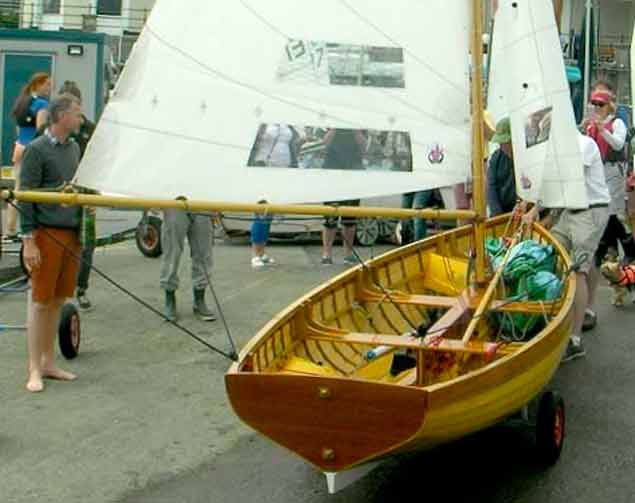 A Grade A (Hons) teaching project……The new Water Wag Dipper, created in Brian McClelland’s boat-building school in Spain, is a masterpiece. Photo courtesy Waters Wags
A Grade A (Hons) teaching project……The new Water Wag Dipper, created in Brian McClelland’s boat-building school in Spain, is a masterpiece. Photo courtesy Waters Wags
The Water Wags, as one of the healthiest One-Design classes in Dun Laoghaire, or indeed all Ireland, have the immediate impetus of their racing programme - combined with other special events - to keep them busy and enthused. But with other characterful designs, there’s always the possibility that the actual business of creating the boat becomes the main purpose of the exercise. Without suitably interesting waters on which to sail them, some one-off classic restorations can go largely unused.
Yet here again, Ireland is uniquely placed to provide a real service. We already can draw on an unrivalled heritage of interesting designs just asking to be built anew. But as well, our special combination of historical sailing centres with yacht and sailing club programmes of time-honoured provenance, when combined with our remarkable mixture of coastal and inland waterways, provides sailing and boat-use settings for every need.
Thus while some classic boats thrive in a crowded class racing and sailing situation, others need more secret waters to give of their best in a setting with a sense of privacy. So although Mike Newmeyer’s Skol ar Mor in Brittany has been much in evidence in Howth recently with the School’s distinctive shade of green highly visible in the keenly-raced new Howth Seventeen Orla, that same shade of green was somehow less conspicuous when it recently and quietly appeared on two characterful little Skol ar Mor-built boats at one of those semi-private harbours you’ll find on most coastlines of the Shannon lakes.
 The distinctive Skol ar Mor green livery is seen on the Whitehall 14 and the 13ft Beetle at a secluded harbour on a Shannon lake’s western shore. Photo: Ian Malcolm
The distinctive Skol ar Mor green livery is seen on the Whitehall 14 and the 13ft Beetle at a secluded harbour on a Shannon lake’s western shore. Photo: Ian Malcolm
 The Beetle cat under sail – she is designed to sail on her marks with two adults in the cockpit. Photo: Ian Malcolm
The Beetle cat under sail – she is designed to sail on her marks with two adults in the cockpit. Photo: Ian Malcolm
Many of these harbours are on the river and lake system’s west shores, in Connacht and Clare, and one of these was the venue for the low-key gathering of Judith Malcolm’s 13ft cat-rigged Beetle-type Emelline, and Guy and Jackie Kilroy’s 14ft Whitehall New England rowing boat, both of them American concepts. For a bit of balance, in attendance were two craft owned by wooden-boat serial collector William Prentice - a 12ft lug-rigged Coot sailing dinghy from Andrew Wolstenholme, and a beautiful Shannon classic lake boat, 18ft of elegance crafted by Edwin Brennan in Dun Laoghaire to bring back to life a boat owned a very long time ago by William’s father.
 For a boat developed for rugged multiple uses in New York Harbour in the 19th Century and earlier, this new Whitehall dinghy has found an unexpectedly serene berth on an Irish lake in 2018. Photo: Ian Malcolm
For a boat developed for rugged multiple uses in New York Harbour in the 19th Century and earlier, this new Whitehall dinghy has found an unexpectedly serene berth on an Irish lake in 2018. Photo: Ian Malcolm
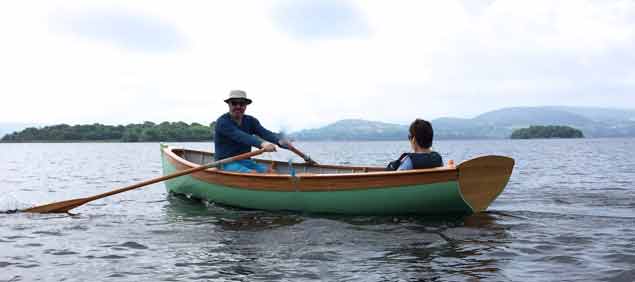 The concept of the best use of the Whitehall is based on weight distribution – and when speed and extra power are required, two sets of oars can be deployed. Photo: Ian Malcolm
The concept of the best use of the Whitehall is based on weight distribution – and when speed and extra power are required, two sets of oars can be deployed. Photo: Ian Malcolm
In terms of flotilla size and crowd numbers, it was a matter of small is beautiful, and less is more. But it provided time and leisure to contemplate the boats properly, and consider how Ireland fits into the broader wooden boat picture.
In a quiet sort of way, things are on the move. In an international exchange programme, apprentices from Skol ar Mor did a course with master craftsman Dougal MacMahon at Belmont in County Offaly, while down in Ballydehob in West Cork, Rui Ferreira is already well into lofting up yet another new Water Wag. And up in Kilrush in County Clare on the north shore of the mighty Shannon Estuary, Steve Morris – originally from New Zealand – is re-building a cold-moulded version of the classic Alfred Mylne-designed Dublin Bay 21 Naneen for Hal Sisk and Fionan de Barra, a design which first saw the light of day in 1902.
Other projects are on the move, and wooden boat traditional and classic enthusiasts in Ireland find themselves with an excellent selection of designs and types to choose from, and every possible sort of water on which to sail them. The only unknowable is the weather…….
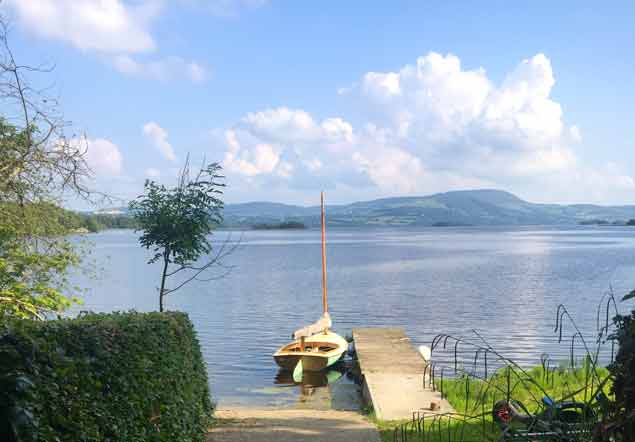 Summertime on the lake, and the Beetle Cat can be ready for sailing in minutes. Photo: Ian Malcolm
Summertime on the lake, and the Beetle Cat can be ready for sailing in minutes. Photo: Ian Malcolm
Despite some interruptions from either too much or too little wind, the regular club sailing programme for 2017 is now fully under way, and this weekend is additionally so well filled with major regional and national events that you could be forgiven for thinking it’s high summer already. W M Nixon tries to make sense of it all.
How on earth is anyone expected to fully understand, let alone explain, a global activity which today sees the extraordinary 1,500 boat Festival of Sail in the Morbihan in France putting in its final races and fleet manoeuvres, before everyone joins in the end-of-show Parade of Sail tomorrow?
Yet at the same time, across the Atlantic in Bermuda, the first moves in the 35th edition of the America’s Cup, arguably the world’s oldest international sporting contest as it goes back to 1851, are getting under way, involving sailing machines for which the word “boat” seems somewhat inappropriate.
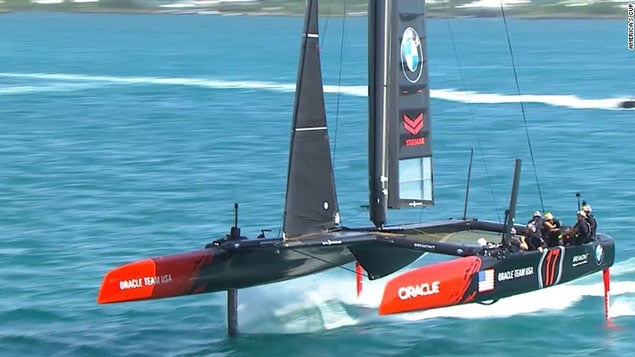 It’s difficult to think of them as anything other than “sailing machines,” but America’s Cup rules reckon they are boats
It’s difficult to think of them as anything other than “sailing machines,” but America’s Cup rules reckon they are boats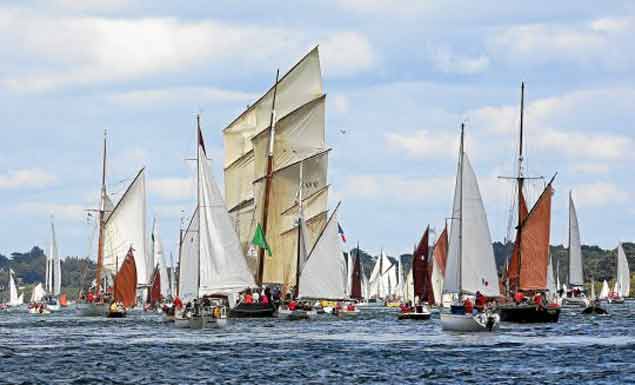 Some of the huge fleet at the current Morbihan festival. In their midst is the bisquine-rigged La Cancalaise from Cancale. In the days of piracy, smuggling and privateering in the English Channel, it was reckoned that any vessel setting this demanding high-performance rig was up to no good, and therefore a legitimate target for government ships
Some of the huge fleet at the current Morbihan festival. In their midst is the bisquine-rigged La Cancalaise from Cancale. In the days of piracy, smuggling and privateering in the English Channel, it was reckoned that any vessel setting this demanding high-performance rig was up to no good, and therefore a legitimate target for government ships
Then too, the world sailing community is still digesting the revelation that future generations of boats in the Volvo World Race, which now rivals the America’s Cup for international attention, will be in effect IMOCA 60s with mega-foils.
And in addition to that, at each in-harbour stopover, the world-girdling Volvo Ocean Race crews will be expected to do a series of races in smaller but very potent multi-hulls which will thrill spectators with their closeness to the watching crowds and to each other, with hair’s breadth misses – and ideally the occasional not-too-serious shunt - a central part of the action.
All these major international events then have to be fitted around the reality that, like it or not, sailing is one of those minority sports that need the Olympics more than the Olympics need sailing. In other words, we have to keep the decks clear of other major international fixtures to give total attention when the next sailing Olympiad at Tokyo comes along in 2020.
For those who would snort in derision at such a suggestion, do tell us what you were doing (if you can remember) while the rest of Ireland held its breath and watched as Annalise Murphy was sailing towards her Silver Medal on August 16th 2016?
Nevertheless, having taken all that into account, the reality is that the top end of sailing is reaching ever-higher peaks of performance in everything, and inevitably using boats and equipment of unimaginable expense. So except for the Morbihan event - whose ethos is found in going the other way, with total democratic involvement for everyone - how on earth can ordinary sailors relate to what the participants in the America’s Cup and the Volvo World Race are experiencing?
Let’s be honest. We can only do so - if at all - with some mighty leaps of the imagination. The result is that many of us are going back to the knitting. We’re going back to trusted events, and staying with sailing boats which may not be in the first flush of youth, but at least they mean something to us.
We know that with them, we can find racing which bears some relation to everyday life rather than the other-world dreamscape which is the America’s Cup or the Volvo World Race.
Over the next two weekends in Ireland, this racing of familiar boats will move up a couple of gears, as this weekend is the Bank Holiday in the North, and in a week’s time the extra day off is in the Republic. So keen sailors who see their programme on an all-Ireland basis somehow manage to convince themselves that we have two all-island Bank Holidays on the trot.
 Galway hookers gather at the Claddagh, while above them is the Galway City Museum, currently staging a Marine Science Exhibition.
Galway hookers gather at the Claddagh, while above them is the Galway City Museum, currently staging a Marine Science Exhibition.
Thus the ongoing Claddagh Festival with all varieties of Galway Hookers on show in the City of the Tribes is also managing to welcome Viking longships which have been brought overland from their home port of Ardglass in County Down. And at least the northerners have the proper claim that, for them, Monday is a free day to get their boats home again.
That equally applies to northern visitors to the Woodenboat Festival in Baltimore, which got going last night and should have good weather from midday onwards today, and through tomorrow’s colourful programme. Nevertheless for those with a day job to think about, the long haul home on Sunday night can become very long indeed.
 Baltimore in West Cork - the perfect location for a friendly Woodenboat Festival
Baltimore in West Cork - the perfect location for a friendly Woodenboat Festival
 It’s not quite racing, but when a Galway hooker (left) finds competition at Baltimore Woodenboat Festival with a traditional West Cork boat, there’s certainly an added edge to the sailing. Photo Sheena Jolley
It’s not quite racing, but when a Galway hooker (left) finds competition at Baltimore Woodenboat Festival with a traditional West Cork boat, there’s certainly an added edge to the sailing. Photo Sheena Jolley
Both these events are traditional annual festivals in which racing plays only a small – if any – part. But even in competitive sailing, all the signs are that people are returning to beef up the numbers and competition in events which served them well in the past, yet had slipped in the popularity ratings owing to a change in behavioural patterns (the modern family is an extremely demanding taskmaster), and the ill-effects of the economic recession.
Everyone has been heartened by the new strength of the Irish Sea Offshore Racing Association (to which we’ll return in a minute), but today the top of the agenda is the Scottish Series, getting up to speed at the lovely little port of Tarbert on Loch Fyne. Of course, numbers are nothing like the eventually unmanageable crowd of boats which became a feature of this series about twenty years ago. But nevertheless there’s a tidy fleet at Tarbert, and a strong Irish contingent are in with more than shout of bringing home the big prize.
 Packing them in – the Scottish Series fleet in Tarbert
Packing them in – the Scottish Series fleet in Tarbert
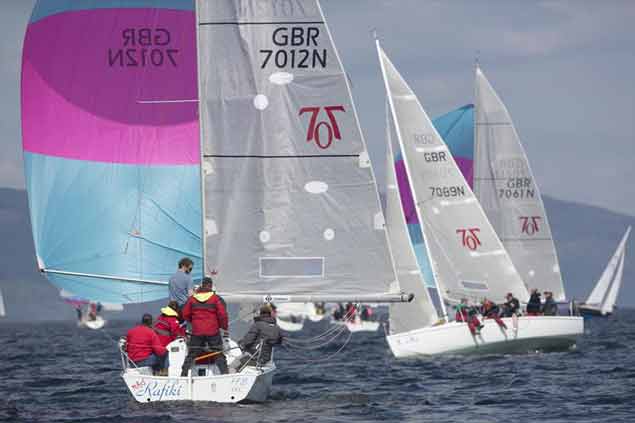 The Hunter 707 fleet provided some of the best racing at last year’s Scottish Series
The Hunter 707 fleet provided some of the best racing at last year’s Scottish Series
 Dara O’Malley (second left) and his winning crew on Seaword, which made him Afloat.ie “Sailor of the Month” for May 2016. Photo: Marc Turner
Dara O’Malley (second left) and his winning crew on Seaword, which made him Afloat.ie “Sailor of the Month” for May 2016. Photo: Marc Turner
Last year it was one of the diaspora, Dara O’Malley originally from Westport but now sailing on the Firth of Forth with his Hunter 707 Seaword, who was tops. While he may be Scottish-based, he was home among us in January to receive his Afloat.ie “Sailor of the Month” Award for May 2016 at the National Sailing Awards in the RDS.
He is defending this weekend, and another former overall winner is the irrepressible Rob McConnell from Dunmore East. With an almost entirely Waterford Harbour SC crew, Rob’s A35 Fool’s Gold is reportedly in particular good trim this year, so definitely a boat to watch.
Other strong performers from Ireland over in Tarbert include the Kelly family from Rush with their J/109 Storm, and that highly individualistic helmsman renowned for pulling rabbits out of the hat, Johnny Swan with his classic Half Tonner Harmony from Howth. Strangford Lough is sending the notably steady perfomer Jay Colville with his successful First 40 Forty Licks, while all the way from Cork Harbour is the First 36.7 Altair (K Dorgan & J Losty) of Cove Sailing Club, recalling the enthusiasm of a high order which used to be a feature of the O’Leary family’s years with the Corby 36 Antix from Crosshaven, an overall winner in Scotland on more than one occasion.
 They might do it again......Rob McConnell (fourth left) and his mostly Dunmore East crew after winning the Scottish Series in 2015 on the Archambault 35 Fool’s Gold. Photo: Marc Turner
They might do it again......Rob McConnell (fourth left) and his mostly Dunmore East crew after winning the Scottish Series in 2015 on the Archambault 35 Fool’s Gold. Photo: Marc Turner
The continuing growth of the J/109s, which have needed ten years to become an overnight success in Ireland, is shown by the additional presence in Scotland of two of Storm’s sister-ships from home, Andrew Craig’s Chimaera and John & Brian Hall’s Something Else, while a smaller manifestation of the J Boat range’s ubiquitous nature is the participation of Stephen Quinn’s J/97 Lambay Rules from Howth.
It’s an interesting crew setup, as Lambay Rules’ core team, including Stephen Quinn himself, have been seen racing in the elegance of Stephen O’Flaherty’s Spirit 54 Soufriere, whose claims to fame include a role in a James Bond movie. Despite the obvious differences between the two boats, the key personnel – including Stephen O’Flaherty – moved aboard the little Lambay Rules for last year’s Volvo Round Ireland Race, and despite being one of the smallest boats in the fleet (in fact, I think she was the smallest), at several stages they were leading their class, but not alas at the finish.
Their determined involvement in Scotland says much for their continuing zest in the game, but meanwhile back home the presence of so many significant boats over in Scotland has done little to diminish numbers for this morning’s ISORA Race from Dun Laoghaire to Arklow, which will see 28 starters.
PHOTO HERE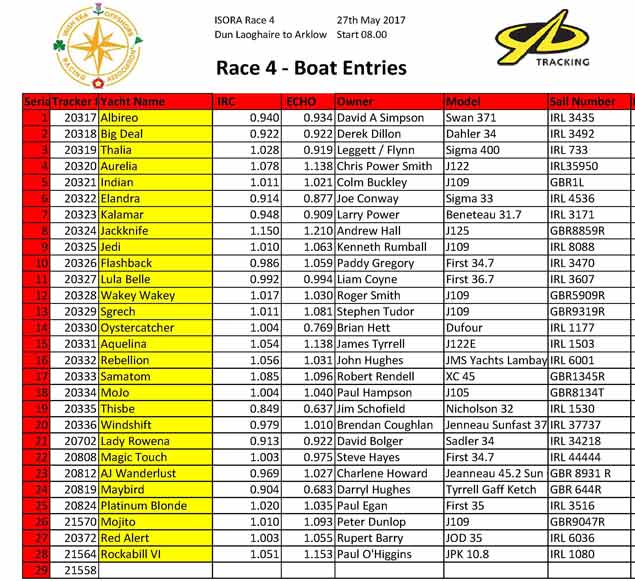 The lineup for today’s ISORA-Dun Laoghaire Race
The lineup for today’s ISORA-Dun Laoghaire Race
Very senior ISORA contenders have a feeling that they must have raced to Arklow before, but maybe they’re confusing it with ISORA races which took in the Arklow Lightvessel as a mark of the course, and it’s undoubtedly a very long time since a lightship was on the Arklow Bank.
Certainly ISORA Chairman Peter Ryan says that this is the first time an ISORA Race has finished in Arklow, where the local sailing club has been expanding in a healthy style, while on the bigger canvas, the Tyrrell family with their succession of ever-larger and successful craft in the J Boat range – all called Aquelina – has done much to have Arklow SC punching way above its weight on the national offshore racing scene.
The Tyrrells were too far ahead of the curve when they got their first Aquelina, a J/109, shortly after the new marque was introduced. Their hopes of getting a semi-One-Design J/109 class going didn’t take off. But today, racing their current J/122E Aquelina back to their home port, they’ll ruefully observe that there are at least five J/109s racing with them, a goodly number when we remember that three of the Dublin class are in Scotland, and several others are staying in Dun Laoghaire to do today’s Dublin Bay SC race.
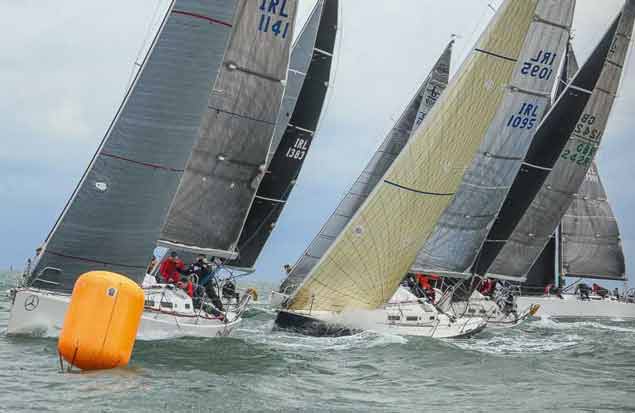 It has taken them ten years to become an overnight success, but the J/109s are now a very significant presence in Dublin Bay. Photo: Afloat.ie
It has taken them ten years to become an overnight success, but the J/109s are now a very significant presence in Dublin Bay. Photo: Afloat.ie
However, one of the latest J/09s to join the Greater Dublin class is Indian, owned by Colm Buckley and Simon Knowles of Howth. They won the two-handed class in the 2015 Dun Laoghaire to Dingle race in the smaller Elan Blue Eyes, but this race to Arklow is their first serious offshore challenge in the J/109. It will be a proper test, as the J/109 contingent includes Peter Dunlop’s Mojito and Stephen Tudor’s Sgrech, both from Pwllheli and respectively first and second of the J/109s in the Holyhead to Dun Laoghaire race a fortnight ago.
But the boat for everyone to beat is Paul O’Higgins’ JPK 10.80 Rockabill VI, whose remarkable all-round ability was demonstrated with the overall win in the increasingly breezy Holyhead-Dun Laoghaire Race of May 13th. These JPK 10.80s are superb performers across a wide range of conditions, and the simple fact of knowing they have such a good boat under them is an added encouragement for Paul O’Higgins and his crew of all the talents.
The highly technical approach of racing a boat like Rockabill VI is a whole world away from the intimate world of wooden boat adherents getting together in Baltimore, or the historical, cultural and music-laden gathering of the traditional craft and their visiting Vikings in Galway. But that’s the way it is in the very wide world of boats and sailing. In the end, we’re all members of the same exceptionally diverse sailing community.
 The boat to beat – Paul O’Higgins JPK 10.80 Rockabill VI is a superb all-rounder
The boat to beat – Paul O’Higgins JPK 10.80 Rockabill VI is a superb all-rounder
#woodenboat – A short documentary (eight mins) about David Welsford, who has given up the luxuries of land in search for happiness and adventure on a 50–year old classic wooden boat he restored from a scrap heap.
In March 2009 Welsford came across a 28–foot yacht dry docked on the Port of Bridgewater, Nova Scotia. This long forgotten wooden boat (Lizzy Belle) had been built in Chester, NS in 1968 and was designed by L. Francis Herreshoff as an offshore sailing yacht. Without any engine or spars (masts) her future was bleak. Negotiations with the owner in a small pub in Halifax resulted in his favour.
The next five months were spent examining and restoring every detail in her hull, decks and quarters. Cracks were filled in her hull, dry rot replaced in her bow, a used engine installed, sanding, painting and and caulking seemed endless. Main and mizzen masts were scoped out and purchased. Lizzy Belle was revived. She had a second chance at life and little did Welsford know, she gave him one in return. Owning and maintaining a traditional wooden sailboat requires continuous loving care. In return she provides him with the thrill of the open ocean sail, the challenge of seemingly endless creative problem solving, and the enjoyment of preserving an important part of Nova Scotian Heritage.
#woodenboat – The wonderful world of Ireland's wooden boats is a winding trail. W M Nixon went to West Clare to see one boat, but unexpectedly happened upon another with which he was totally smitten. Then he found the original objective of his travels was even better than expected. And finally back home, he found the project to re-create Asgard's 10ft dinghy from 1905 has produced a gem of classic boat-building.
With Sally O'Keeffe, it's love at first sight. I defy anyone to resist the allure of this shapely beauty.
You may have heard of this community project in southwest Clare, to build a replica of the working cutters which used to ply their trade in the demanding waters of the Shannon Estuary. And like me, you may even have noted with pleasure that the designer to the project was Myles Stapleton of Malahide, the great unsung star of Irish naval architecture, who has never drawn an unharmonious line in his life.
Yet like me, while you may have been aware that the boat was first launched in 2012, somehow neither of us has ever been in the presence of this remarkable little ship. And this despite the fact that she has been cutting a swathe through the fleet at classic and traditional events between Galway Bay and Baltimore for the past year and more.
Even with all this, I was actually trying to find the whereabouts of another new wooden boat entirely when I stumbled upon Sally O'Keeffe - newly-launched in Kilrush last Saturday - and was instantly smitten. For she's only gorgeous. She looks so utterly right, she's mad keen to sail which she does very well indeed, and she brings much pleasure to everyone involved. This has to be the community project par excellence. But then, Querrin in West Clare is a genuine community par excellence, an idea and vision as much as a place.
It's spread out on your left down towards the Shannon Estuary as you enter the Loop Peninsula, which is Ireland's ultimate place apart. Loop Head's island atmosphere is very marked, with the extensive but shallow Poulnasherry Bay west of Kilrush pushing northwest deep into the land, almost to Kilkee. Thus places like Querrin, until well into the 19th Century and even later, were much reliant on goods being landed at and exported from their little quays.
The Shannon Estuary is a mighty highway, but with the biggest tides in Ireland – 5.6 metres range at top of springs – the workboats carrying the vital goods had to be multi-functional and capable of taking aboard diverse cargoes. Not least of the requirements was a good all-round sailing ability, for although the Galway Hookers away to the north largely plied their trade by reaching back and forth across Galway Bay from Connemara to the Aran Islands, the Shannon Hookers had to excel in windward ability in order to sneak along inside the inevitable foul tides, and weather the increasingly difficult headlands which they encountered as they made their way west. Thus the boats which regularly sailed to Querrin were among the most able on the estuary, and long after the last of them sailed, the folk memory of their significance lingers on.
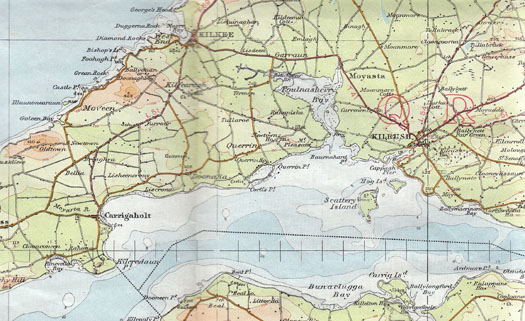
Querrin at the heart of things. Once you get west of Poulnasherry Bay, you're in the remote island-like atmosphere of the Loop Head Peninsula. Loop Head itself is another six miles west of the left edge of this map

Sally O'Keeffe provided a formidable design challenge for Myles Stapleton, as he had to create a roomy and high freeboard hull which still managed to incorporate elegant curves, yet all within an overall hull length of only 25ft. And of course, she had to sail very well too. Photo: W M Nixon
It was thought that the ribs of one of the old sailing workboats were sticking out of the mud at Blackwater Bridge on the road approaching Querrin from Moyasta. So as a local Querrin Sailing group began to gain traction, they got the notion of getting those last remains out of the mud, and restoring a proper Shannon Hooker to be the flagship of their little fleet, and the focus of a worthwhile community project in boat-building.
Perhaps it's as well the old wreck proved to be no more than shallow-water cot, for this seeming disappointment led eventually to designer Myles Stapleton and a magnificent but manageable project to build a new 25ft Shannon Hooker, using ancient photos and old drawings to re-create the best of the type.
In Querrin, Ned Griffin lent his fine shed up the hill for building the new boat, and as she took shape he also came up with the perfect name. In the 19th Century, Sally O'Keeffe had been the wife of a Querrin-based sailing workboat skipper, and she was a woman still remembered. It's a name of great style, but lest anyone think it's just too good to be true, let it be known that in 2012 as the new boat was making her debut, didn't Sally O'Keeffe's grandson – aged a hundred – return from America to give his blessing?
The building had started in 1910, and this Seol Sionna project drew on many sources and much voluntary labour, both within southwest Clare and further afield, to reach completion. They had the benefit of the extensive knowledge of traditional craftwork guru Cristoir Mac Carthaigh, who may be best known for his work in traditional boats, but if you've a bit of old-style thatching in mind, he can help you there too.
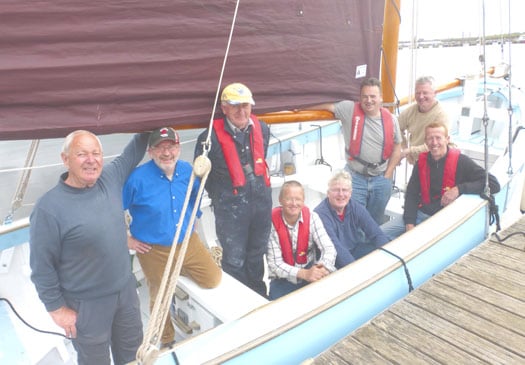
Some of the team at Querrin Sailing who built and sail the Sally O'Keeffe. Seen aboard on launching day at Kilrush are (left to right) Joe Hassett, Criostoir Mac Carthaigh, Michael O'Connell, Stephen Morris, Dixie Collins, Fintan Ryan, John Kennedy and Stephen Courage. Photo: W M Nixon

Steve Morris. Photo: W M Nixon
As for the building team, the trainee boatbuilders ranged in age from 16 to 80. It all became very possible thanks to Steve Morris, a fully-qualified New Zealand boatbuilder who came to Ireland a long time ago while taking a world backpack tour, and somehow stayed. He got involved in the building of the Jeannie Johnston on Tralee Bay in 1986, and for several years now he has lived near the shores of Poulnasherry Bay, and is a pillar of the maritime scene locally and nationally.
Steve served a full five year apprenticeship in boat-building in Auckland, so the community boat-builders of Querrin have had guidance and teaching of gold standard. In fact, thanks to Steve's input and the enormous goodwill and enthusiasm which the project engendered, it's doubtful if she could have been better built anywhere else in Ireland, while this video of him demonstrating caulking skills shows the standards to which they worked.
The ethos underlying the project has been eloquently articulated by Richard "Dixie" Collins, another of the key movers and shakers in Querrin Sailing:
"This is very much a community project from Loop Head peninsula. A keen, salty group who are sharing skills and enthusiasm for getting out on the ocean, to a place with a big sky and lots going on. There is training in seafaring skills for people who have never been out in a boat, and we provide trips to islands, and old piers which were built for boats like this in another time.
Our logo is taken from a gravestone in Scattery Island church of a boat-builder by the name of O'Mahony in 1832. In this small rural part of the western seaboard, we have built a sailing boat which we can maintain ourselves, and we offer sailing opportunities for everyone in the area for a five euro contribution to the club. An important outcome is the capacity building with new relationships, generational sharing of learning and having a right good time ourselves. It strengthens our sense of community, and is a shared credit to the collective efforts of everyone."
Despite the robust hull's obvious sailing power, Sally O'Keeffe needs only one hand on the tiller.
As the Sally O'Keeffe was going to be kept undecked with her hull limited to 25ft overall, for safety reasons they had to ask Myles Stapleton to give her quite high freeboard. It says everything about his skills as a creator of good-looking boats that despite the high freeboard – which has proven a Godsend in both the Estuary and on some remarkable and swift coastal passages on the open Atlantic north to Galway and south to Baltimore – the Sally O'Keeffe has a tremendously vigorous style to her appearance. It lifts the spirits just to see the sweep of her sheer and the elegant way in which the transom stern is incorporated in a sweet yet powerful run aft.
In 2013 she sailed forth more than seventy times, and while the highlights were the voyages to Galway and Baltimore, the essence of her popularity is the shorter jaunts within the Estuary, captured very effectively on this brief video by John Collins taken aboard after overnighting with a camp on Canon Island.
Despite a tiller of only average length, she is easily steered – in fact, "finger-tip control" is the theme of much of her sailing. As for her speed, it has pleasantly surprised everyone involved, and the visit to Baltimore found the little 25-footer from the Shannon pacing with or even over-taking the 33ft mackerel yawls from West Cork.
The Baltimore Wooden Boat Festival (this year's is from 23rd-25th May) is the gathering of the crème de la crème of Ireland's wooden boatbuilders. The very fact that they can be up and running so early in the season is proof they're the tops, but as the Baltimore maritime calendar is so full of events, this is when the timber tribe has to take to the seas, even if many older wooden boats elsewhere in Ireland seldom put a toe out until June.

At the Baltimore Wooden Boat Festival 2013, Sally O'Keeffe found herself pacing with the larger 33ft West Cork mackerel yawl

Baltimore Wooden Boat Festival gathers the crème de la crème of the traditional and classic boat-building brotherhood. This is Rui Ferreira of Ballydehob sailing the Castlehaven Ette Class dinghy which he built, with Sally O'Keeffe in the background making her Baltimore Debut
Meanwhile, nearer home, Querrin Regatta is today. That's right, Saturday May 10th. Unfortunately the weather prospects aren't great, with the jet stream squatting over Ireland like some vast demented dragon. But at least the Sally O'Keeffe is in proper order, as she demonstrated during some heavy weather sailing in the Estuary on Bank Holiday Monday. And the famous West Clare racing currachs are up for it too – last Sunday we saw one of the renowned Doonbeg racing currachs in intensive training off their little port, where the inner reaches now have a handy pontoon in a pool in the river.
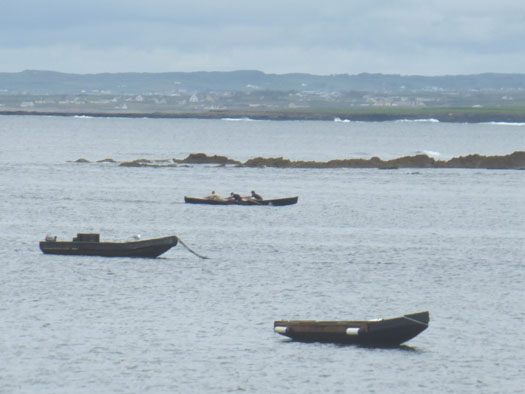
The western way. Racing currach at Doonbeg in training on Sunday morning. Photo: W M Nixon
One local boat which definitely won't be at today's Querrin Regatta is the reason we ended up in Kilrush in the first place. This is Steve Morris's own special pet, and it was Kim Roberts of Askeaton who suggested that this was worth seeing. It certainly is. He has taken a classic Harrison Butler Khamseen design, which is remarkably like an anticipation of Lyle Hess designs like Fred Schotman's Raven from the Netherlands which was in Dublin Bay last year, and is creating his dreamship at home.
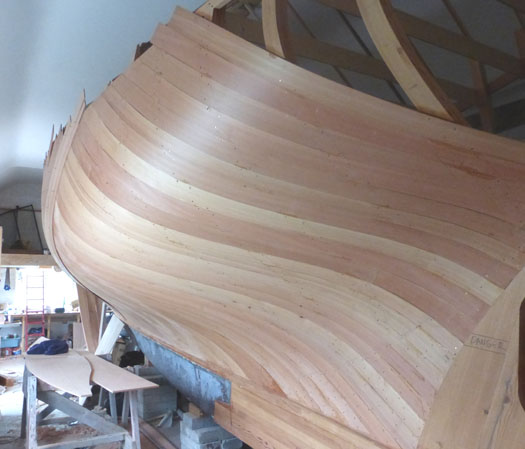
The port side of Steve Morris's 31ft Harrison Butler design looking forward, with the rich texture of the Alpine larch glowing through. Photo: W. M. Nixon
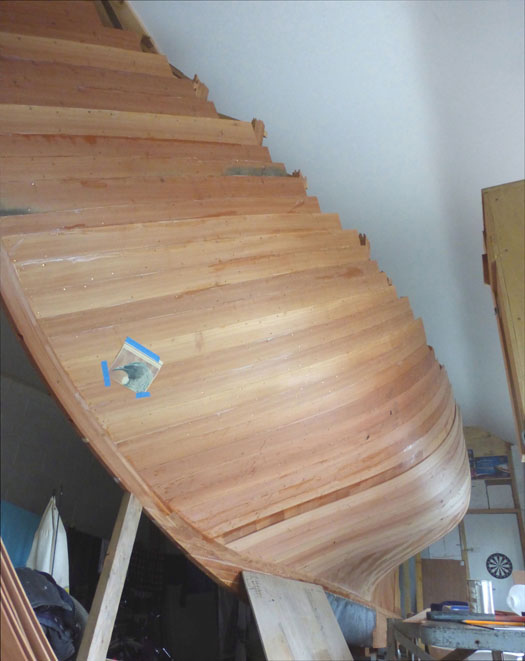
Don't try this at home.....Steve Morris has managed to fit this 31ft hull into the garage beside his house. Photo: W M Nixon
Steve is building this honey of a boat in multi-skin, using dark dense Alpine larch, the leftovers of a consignment of timber which was brought in from Austria for the building of Jeanie Johnston. The man works so neatly that he has managed to fit the entire project into the admittedly spacious garage beside his house near Moyasta, and the workshop is one of those spiritually-enhancing places which are a balm for the soul.
Particularly impressive is the perfectly-shaped lead ballast keel which fits so well into Harrison Butler's flowing lines. And it's typical of this job too. For when I asked him who made the form and cast the keel for him, he was surprised by the question, as the answer simply is: "I did it myself, right here on site".
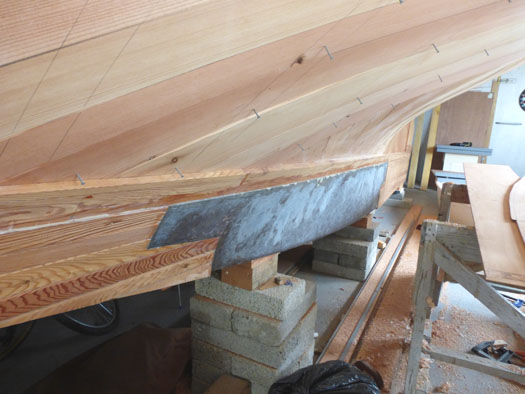
"No problem". The lead ballast keel was cast on site. Photo: W M Nixon
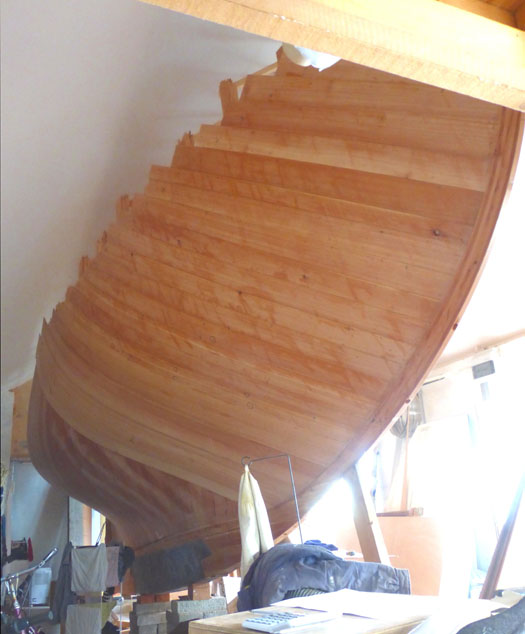
Even with quite a large garage, it's very difficult to get a photo showing all of a 31ft boat. Starboard side looking aft. Photo: W M Nixon
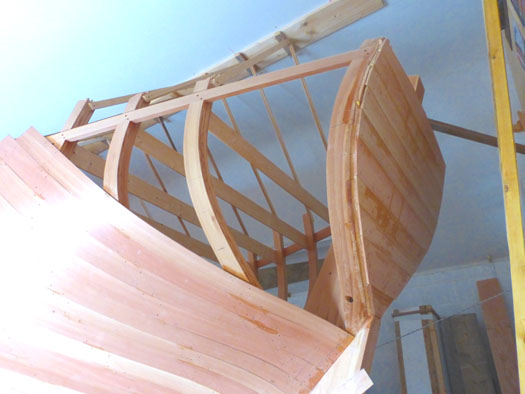
Although the Metacentric Shelf theory of hull design to which Harrison Butler subscribed has been large disproved, he still produced hulls of balanced performance with transom sterns which didn't drag half the ocean after them. Photo: W M Nixon

A dartboard is an essential in any boatbuilding shed. You need something to keep you well away from the job while glue is setting. Photo: W M Nixon
Using "leftover" timber for boat-building projects is an appropriate theme as we emerge from recessionary times. After John Kearon and his team had made such a fine job of conserving Asgard, there were bits and pieces of well-seasoned leftover wood, and they provided enough timber for Pat Murphy and his group of support volunteers to put in train the building of a replica of Asgard's original 1905 10ft dinghy, designed by Colin Archer himself.
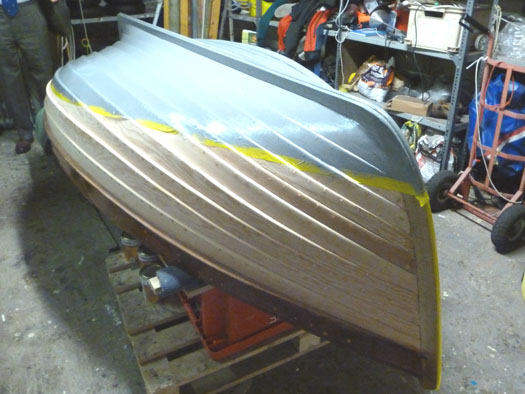
Asgard's dinghy starts to get the finishing treatment. Photo: W M Nixon
It was Fingal boatbuilder Larry Archer (absolutely no relation to the great designer, we're told) who put the little boat together. Like Myles Stapleton when he was tidying up the original drawings of Asgard's lines for a book two decades ago, Larry was very impressed with the way Archer's mind worked, as he designed the transom of the little boat to sit clear of the water when carrying a normal load, thus enabling her to slip easily along without leaving a wake like the inside of a washing machine.

Pat Murphy with Asgard's dinghy. After leading the creation of this little beauty, he understandably has mixed feels about putting her in rugged salt water. Photo: W M Nixon
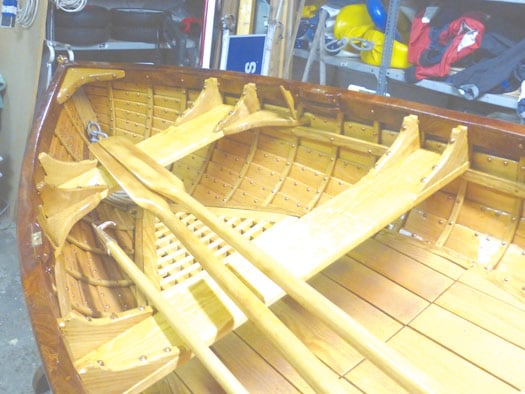
Classic construction and finish detail up forward. Photo: W M Nixon

The interior in the stern – for a ten footer, she is remarkably detailed, particularly where the required twist is put into the planking to maintain a sweet run aft. Photo: W M Nixon
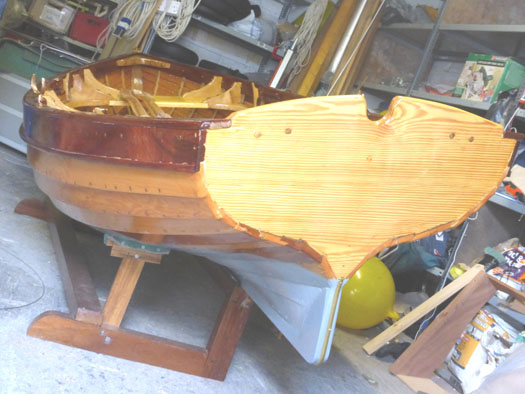
With a clever design to keep the transom clear of the water when the boat is carrying a normal load, Colin Archer created an easily driven yet workmanlike hull. Photo: W M Nixon
It's a remarkable bit of boat design, but with the dry timber it was the very devil to build in the necessary twists.. However, it was done in the end, and the new boat emerged in all her glory, exquisitely finished in classic varnishwork by Pat Murphy and George Elliott, with Neville Maguire making an impressive job of restoring an old set of oars to match the style.
Public debut – Agard's dinghy at Howth Prawn Festival. Photo: Pat Murphy
Asgard's dinghy made her public debut at the Howth Prawn Festival a fortnight ago, and was a star of the show. But the trouble is that when you get a boat finished to this standard, the very thought of putting her into rugged salt water is not appealing. Pat and his team accept the fact that the Asgard dinghy will have to go afloat for the Erskine & Molly Childers Asgard Centenary at Howth on Sunday July 27th. But for now they're much happier just admiring this gem as she shines in the shed, safe from the sea. And who can blame them?
#modelboat – Pirate ships were made of wood, viking ships were also build of wood, in fact a lot of boats were made using this noble and natural material, wood writes Gilbert Louis.
But nowadays most of the boats are build using composite materials like fibreglass, carbon, kevlar, aramid, honeycomb etc...I said most because some are still built in wood. I used to race a Europe dinghy made entirely in mahogany over 25 years ago when I was racing in this class in France and yet I was as competitive as with a fibreglass one.
Some model boat classes like the IOM (International One Metre) forbid the use of exotic composites like carbon, kevlar and other expensive type in the building of the boat to keep the cost down. However the class rule do allow fibreglass for the hull and carbon fibre for the fin and rudder but to encourage home build, they allow wood too.
One could think that a wooden boat wouldn't be a performant as a fibreglass one. But they'd be wrong. A German skipper designs and builds his boat (in wood as well as fibreglass), and even builds his spares in wood and uses florist wrapping laminate to cut his sails in and regularly finish in the top ten at international events. This shows that it is not all about the latest design or building material.
There is something magical in a wooden boats, something a fibreglass boat simply can't deliver. I remember my fireball had a a kevlar reinforced hull but a wooden deck and I loved it, it looked fantastic. In IOM I've only sailed fibreglass boats but this is about to change as I am about to take delivery of my first woody or wooden boat.
I am expecting a lot from that boat, and actually think that being in wood will add to the performance as it will be a really stiff boat yet with corrector weights to bring her up to minimum weight (amount of corrector weight still to be determined but expect to put around 100g). Thanks to Neill's great wood working skills who did a fantastic work building his XP.
I will be campaigning this boat going forward – I'm going to build new rigs, get new set of sails will spend time on the water to learn how to get the best of her. Hopefully joining 2 other skippers to see what we can do at the Woody's championships in the UK (reserved to wooden IOM). But also will race against fibreglass boats.
It is the beginning of a new chapter for me and if you want to know more about how I get on with my woody then stay tune as I will write progress and findings here.
To be continued
The Irish Heart is Still in Wooden Boats
#woodenboat – Wood used to be the material of choice for boat-building. But it has long since been superseded by glassfibre and other variations of plastic, while aluminium – for more than two centuries the "metal of the future" - is now widely accepted for small boats which get rough usage but little maintenance. Yet wood still talks to us. It's part of what we are. W M Nixon takes a look at some current Irish wooden boat-building projects.
It's one of the most natural things in the world to feel an affinity for wood, and enjoy working with it. It's right there in our DNA. Back in the mists of time, when early man was emerging from a primitive wandering existence, the ability to make fires and tools and weapons with wood, and even better the ability to create a shelter from wood when no cave was available, could make all the difference between life and death.
Those early humans who saw wood as something beyond the means merely to make a fire had a superior inbuilt survival mechanism. This in time evolved as an instinctive fondness for wood, a positive emotional response to working with it. Even nowadays, when we live in a world dominated by synthesised materials and mass-produced objects, simply going into a traditional woodworking shop or boat-building shed triggers a favourable atavistic response. We feel comfortable. We love to run our hands along the timber, and savour its aroma. Our heads may tell us that plastic and metal work better for many regularly-used objects, but our hearts are still in love with wood.
Any boat-building project in Ireland will always attract a level of interest way beyond the size of the boats involved if the boat is being built in timber. Don't get me wrong, though. Glassfibre is undoubtedly a wonderful boat-building material which – uniquely – is created as the boat is being built. And I've been using a lot of it in the epoxy version in my own boat's re-configuration project. But while you appreciate its excellence intellectually, there are very few people who respond with favourable emotions to the sticky business of working with it, which is something best done as clinically and cleanly and quickly as possible.
Pure working with wood, on the other hand, is just so comfortable, so reassuring. You can happily linger over it. You never find yourself wondering if this is what nature intends you should be doing. On the contrary, in working with wood, we fulfil a natural imperative. And little wooden boats of traditional shape are a special joy.
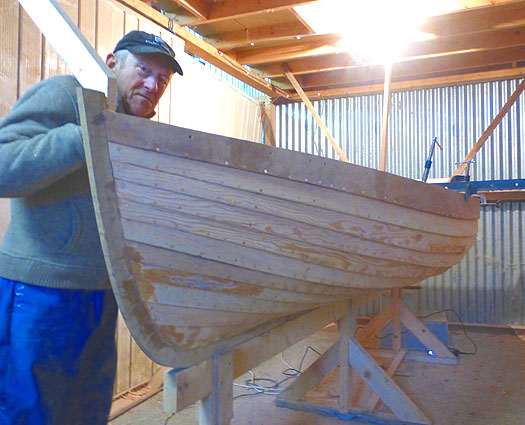
Larry Archer, best known as one of Ireland's leading glassfibre boat-building pioneers, has particularly enjoyed returning to his earlier skills as a classic wooden boatbuilder in re-creating the Asgard dinghy Photo: W M Nixon
Not least of their special joys is that, as we emerge from recession, building a small wooden boat has all the pleasures of traditional boat-building, yet with manageable expense. Thus a classic ten foot clinker dinghy perfectly fits the bill in these straitened times. And as she has the impeccable pedigree of being to a design by the great Colin Archer of Norway, the excellent value for money is beyond dispute as this little boat nears completion in a hidden shed in the depths of Fingal.
But the actual working with wood can be every bit as important as the classic or modern nature of the design, and equally intriguing is the City One project in Limerick. There, people who otherwise mightn't get a chance to build a boat, let alone sail one, are much involved with building modern dinghies to a design by Theo Rye. This is being done in a project under the Ilen umbrella, the Ilen being the Conor O'Brien ketch of 1927 which the Ilen Trust is restoring with trainee shipwrights.
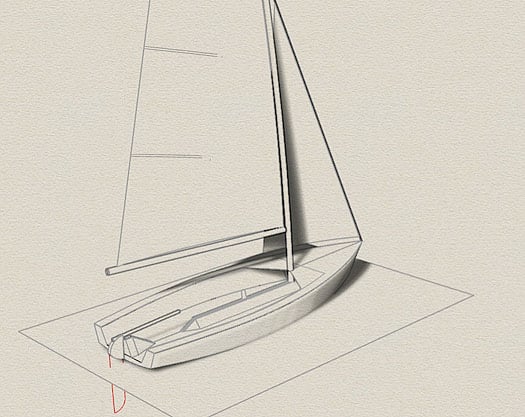
The new City One performance dinghy for Limerick has been designed by Theo Rye.
Over on the East Coast, a boat with distinctive neighbourhood sailing connections can provide a very tangible focal point where a sense of place is sometimes difficult to discern in the region's increasing urbanisation. In Bray, they're reviving that seaside town's local sailing traditions by building new boats to the 12ft Droleen design, which was designed specifically for Bray small boat enthusiasts by local sailing man W Ogilvy way back in 1897.
Ogilvy's original designs had faded, so quite some time ago the Bray people got the late O'Brien Kennedy to re-create them, and the result is such an attractive and able twelve footer that they've not only built the first new one to acclamation in Bray, but across in Spiddal on the Galway coast that renowned boat-builder Jim Horgan of Galway Boatbuilding School – who has created an astonishing total of 200 wooden boats in his time – has built another Droleen for general use in Connemara. It has proven "such a neat little boat", as he so aptly puts it, that another is likely in the near future.

"A neat little boat". The community-built Droleen nearing completion in Bray. The classic design has also been successfully used for a small workboat in Connemara
The Asgard dinghy is a replica of the little boat which Colin Archer designed and built in 1905 for Erskine and Molly Childers to be the tender for the newly-married couple's wedding present from her father, the 51ft ketch Asgard which became part of Irish history with the Howth gun-running for the Volunteers in July 1914.
Asgard is now conserved, and is the centrepiece of a simple yet very effective display in the Collins Barracks museum in Dublin. But as John Kearon and his team neared the completion of their excellent conservation project, the economic recession struck home, and it became clear that Government funds would not run to fitting any sort of rig to the boat.
However, a new squad of Volunteers emerged from a wide variety of sailing backgrounds in the hope of putting some kind of rig in place in order to give a better idea of what Asgard looked like in her prime, using spars which included the original mainboom. There was no stopping this team, which is not surprising when you consider it included global circumnavigator and former dinghy champion Pat Murphy, Arctic explorer and voyager Paddy Barry, long distance solo sailor Mike Alexander, multiple inshore and offshore sailing champion Neville Maguire, and intrepid sailor/boatbuilder Wally McGuirk and his son Rory.
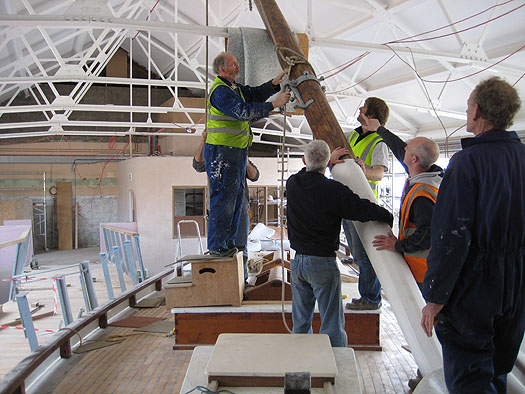
The "new Asgard volunteers" stepping the mast in Collins Barracks. Photo: Neville Maguire

Even though the rig height is very limited by a shortage of headroom, Asgard as she is now displayed looks much better for having something which shows how she appeared when fully rigged. Photo: W M Nixon
Thanks to their work, despite the limited headroom in the Asgard Museum we now have a much better idea of how this wonderful vessel looked in her prime. But as she is so permanently installed as a national monument in Collins Barracks, there's no way she's going to be readily moved for anything, not even the Centenary of the Howth Gun-Running on July 26th this year. So the new Volunteers began to think of building a replica of the Asgard dinghy, whose basic plans were discovered by John Kearon in the Colin Archer archives in the Norwegian Maritime Museum in Oslo.

Sketch plan of the proposed 10ft dinghy for Asgard as drawn by Colin Archer in 1905. Courtesy John Kearon
Though they'd made a fine job of Asgard's shortened display rig, they didn't see themselves as qualified boatbuilders for the detailed construction of a classic little clinker dinghy. But fortunately Fingal boatbuilder Larry Archer – and no, he's not Colin Archer's great-grandson as some have surmised – has the necessary traditional skills in abundance, even if he is noted as one of the pioneers of glassfibre boat-building in Ireland.
In fact, Larry is the classic illustration of my point that much as we acknowledge the sheer good sense of quality boat-building in fibreglass, there is still nothing so profoundly satisfying as traditional boat-building in wood. So he agreed to build a replica of the Asgard dinghy in a manageable budget, and as the boat nears completion, Pat Murphy has raised the money from Asgard well-wishers, and businesses in the Howth area.
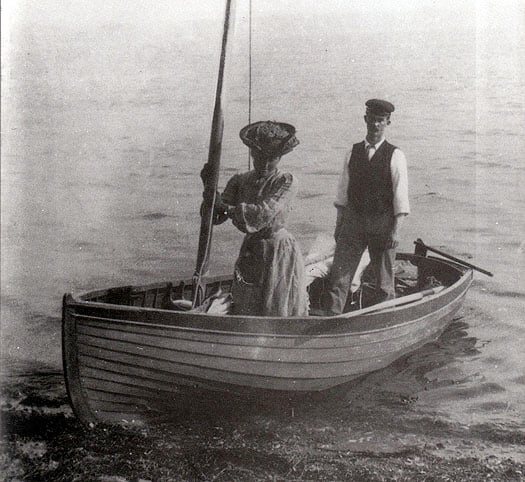
Molly and Erskine Childers with Asgard's dinghy

Asgard as seen from the dinghy during a cruise around 1910 Photo courtesy TCD.
But aside from the historical significance, like the Asgard herself this little boat has a significance all of her own. Nowadays, with the ready availability of inflatables and small RIBS to act as safe cruising yacht tenders which can be stowed on deck, we've forgotten that in times past, cruising people had to make do with dangerously small rigid boats for tenders if they wished to stow them on deck. And if they wanted a high level of safety in their tender, they had to be prepared to tow it.
In fact, in the 1930s, the Clyde Cruising Club had a rule that yachts racing in their annual Crinan to Tobermory Race, which marked the start of the traditional Glasgow Fair fortnight's holiday in July, were obliged to tow their dinghies. Much effort therefore went into designing dinghies which were safe yet sweet of line, and we've a classic photo of the great John B Kearney's 38ft yawl Mavis from Dublin Bay coming in to Tobermory in 1938 after winning the race from Crinan with the little dinghy under tow the whole way.
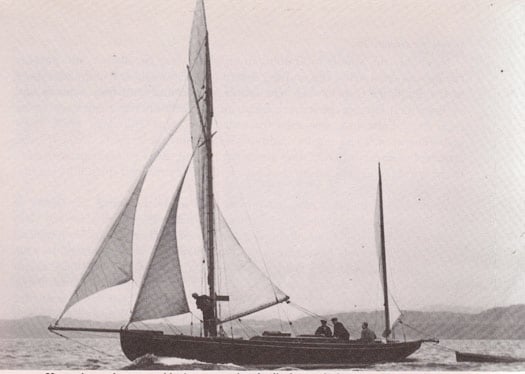
John Kearney's Mavis coming into Tobermory Bay in 1938 after winning the CCC race from Crinan, and towing the dinghy as required by club rules.
There's a direct link to the team connected with today's building of the Asgard dinghy, as the next photo we have is of Neville Maguire in his schoolboy short trousers rowing the Mavis dinghy in to the pier at Schull after placing second in the Irish Cruising Club's 1945 race from Crosshaven round the Fastnet.
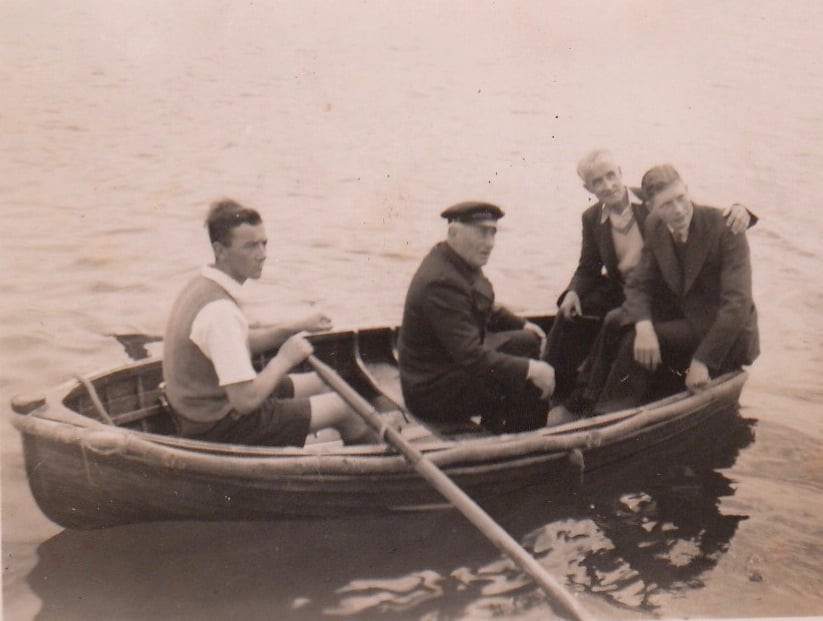
Neville Maguire in 1945, rowing the Mavis dinghy in Schull, with Skipper Kearney amidships.
To work properly, these little dinghies had to be miniature masterpieces, and in re-creating the 10ft Asgard dinghy, Larry Archer had the devil's own job in getting the planking to take on the required twist in under the transom in order to match Colin Archers tightly turned lines, which enabled the little boat to carry weight, yet tow easily and lightly when unladen. In fact, he reckons that the original must have been built with a supple newly-felled tree, whereas he was working with timber left over from the Asgard conservation, and there was one split plank before they got it right for a very fine job.
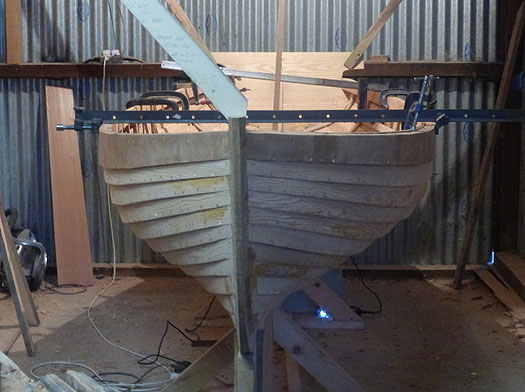
The Colin Archer-designed Asgard dinghy has a particularly elegant shape Photo: W M Nixon

As the Asgard dinghy nears completion, the tight turn to the planking under the transom is clearly seen. Photo: Pat Murphy
The boat wasn't designed with a centreplate, but she carried a little lugsail, and a rudder was fitted. Anyone who has ever sailed a clinker dinghy with the plate up will know that, from a standing start, she'll simply sail sideways. But if you get forward way built up, it's surprising how well the bit of lateral resistance provided by the rudder and the small amount of immersed hull enables you to make better to windward than just a beam reach, allowing all sorts of attractive little sailing options when the mothership is at rest in a pleasant anchorage. And if you do need to make real progress dead into the wind, she rows a treat.
Windward work will be no problem at all with the new City One dinghies from Limerick. Looking at the workmanlike lines drawn by Theo Rye, who got to know Gary MacMahon of the Ilen Trust when they were working together in the Peggy Bawn publishing team producing the massive history of the work of designer G L Watson, the analogy that springs to mind regarding windward work by the City One is "Rat up a Drainpipe".
Construction under way in Limerick on the first City One. Photo: Gary MacMahon
The emerging hull shape, designed for speed. Photo: Gary MacMahon. Photo: Gary MacMahon
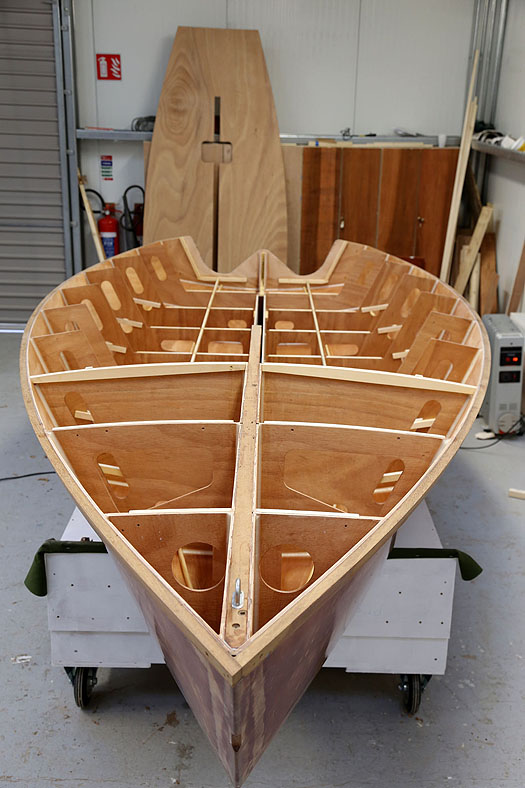
The City One is an impressive example of timber engineering. Photo Gary MacMahon
These will be potent performers, well able to hold up their heads in any race fleet, and it has been a flash of inspiration by the Ilen team to go for this type of boat rather than some sort of conservative option which would provide a maximum number of berths afloat, but a rather dull sailing experience.
By working in wood with the epoxy technique, they're getting the best of both worlds. But the Ilen organisation spreads its tentacles widely, and another of their wooden boat-building project is the re-creation of the classic Shannon and Limerick gandelows, which evolved a flat-bottomed hull shape to be able slither across those acres of mud which are inevitable at low water in the estuary, as Limerick has the biggest tidal range in all Ireland.
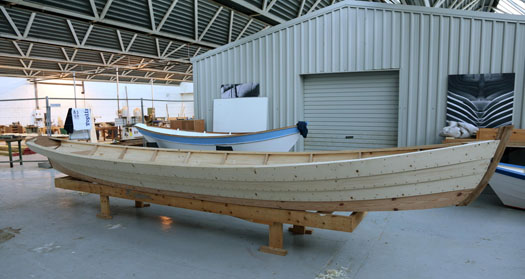
The revival of the traditional Shannon Gandelow is another Ilen Trust project. Photo: Gary MacMahon
Having been in the gondola-building boatyard on one of the Venetian islands (it's a marvellous old workshop, redolent with Stockholm tar and the aromas of fine timber), I have to concede that the Limerick gandelows are only a very distant relation of the classic Venetian originals from which they presumably derived their name. But the international brotherhood of traditional boatbuilding is strong, and the Limerick team will be taking their unusual craft to Venice on 30th April this year for racing displays.

Limerick's Liam O'Donoghue is one of those contemplating the prospect of Shannon gandelows going to Venice to link up with local gondolas. Photo: Gary MacMahon
Meanwhile in Bray so many have been involved with the truly community-wide project to re-create the Droleen class that it might be unfair to single out any one individual, but the popular Barracuda restaurant (it's above the Aquarium on the seafront south of the harbour) has been hugely supportive of a project which has already seen the first boat sailing.
She sets a fascinating rig slightly reminiscent of the setup on the first 1887 double-ended Water Wags. But where the Wags had a standing lug, the Droleens are gunter lug, with the foot of the gaff boom attached to a jaws which slides up and down the mast. Yet that startling spinnaker/jib matches the style of the original Wags, and it anticipates more modern concepts in that, in light airs at any rate, if you keep the spinnaker boom in line with main boom, you can continue to carry the "frontsail" with the wind well forward of the beam.
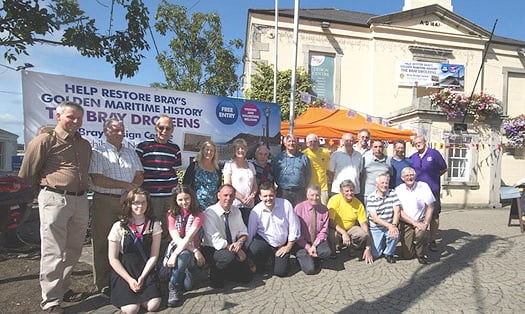
The community group involved with reviving the Droleen class. The first boat will be taking part in Bray's St Patrick's Day Parade.
In the urgency to get the boat sailing before the season had faded away completely, they got a temporary suit of sails stitched up by the fabric shop in Bray's main street, but we're assured that for the season of 2014 they'll have a grown-up suit of sails from noted local sailmaker Harry Sterling. Maybe so, but well done to the fabric shop, their temporary suit looks very well indeed, and the colour is just right to suggest cotton sails of the 1890s.

The new Droleen sailing in Bray Harbour.
The fact that this re-born design has also proven to be an ideal little workboat in on one of the rocky inlets of Connemara is yet another twist in a tale which clearly has legs. And yes, I'm well aware that there are several other wooden boatbuilders in Ireland producing interesting classic and traditional craft each in their own special way. But for now, the Asgard dinghy, the City One performance sailer, the Limerick Gandelow, and the Bray Droleen have given us more than enough to be going along with.
Meitheal Mara’s ‘Boatyard Open Day’
Topics will be on classic and traditional boat repair, restoration and build boatbuilding and lofting to varnish and tarring. The exhibition will feature slideshows and a boat display of a folk boat, Crosshaven clinker rowing punt, thullier sailing clinker punt, Valentia carvel seine boat follower, Rinn Rua, pram dinghies, currachs and canoes.
Also on hand will be Siubhán McCarthy who will be talking about the 'Ocean to City' race and what's happening in Cork harbour. For information contact Meitheal Mara Tel: (021) 4316813 or [email protected]



























